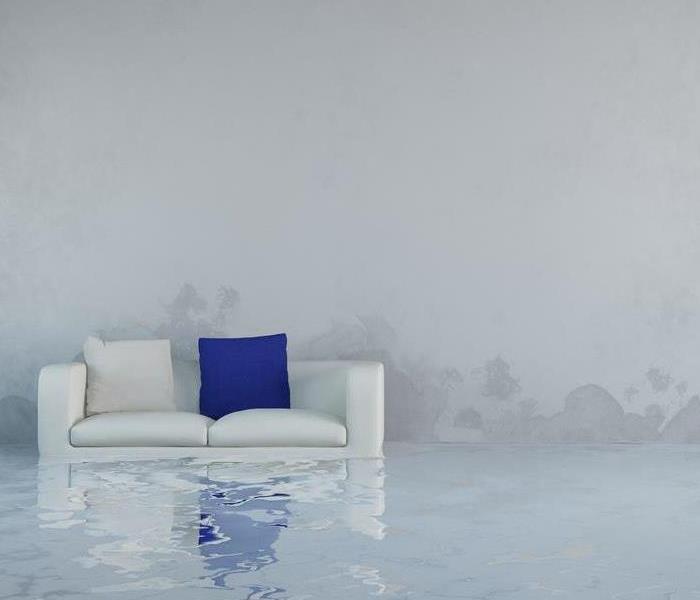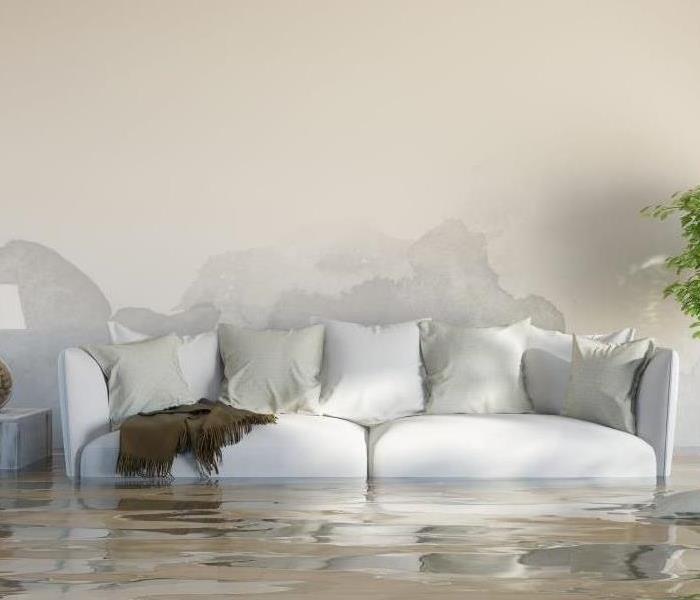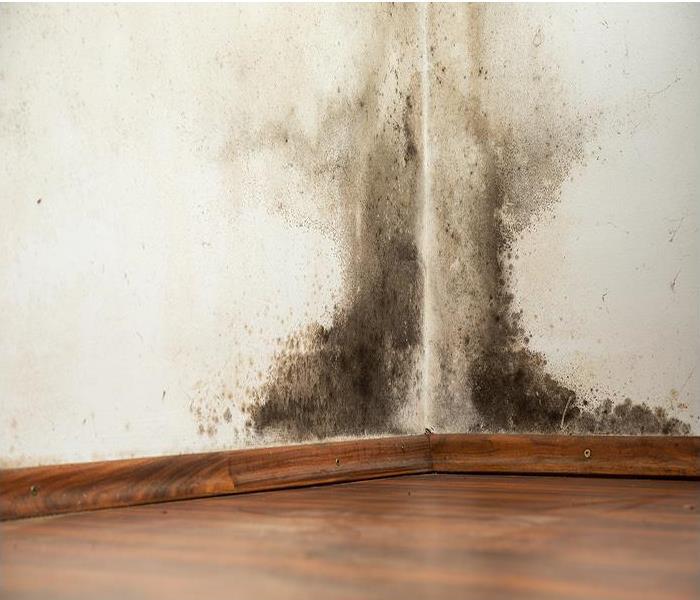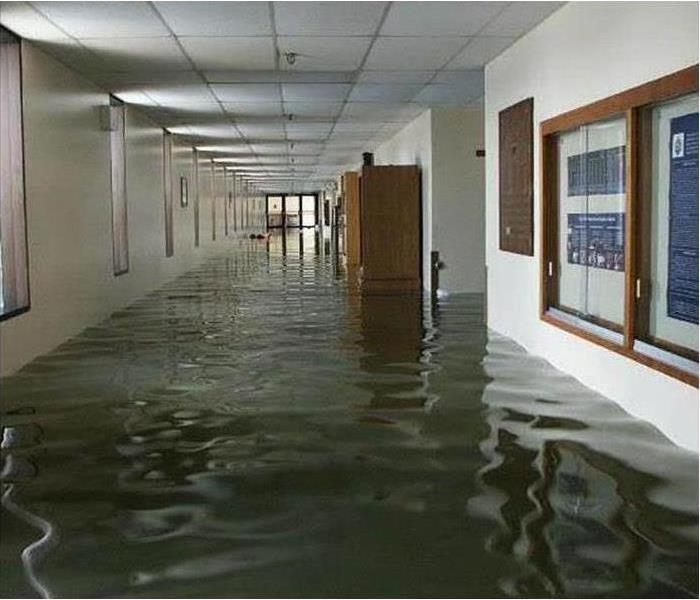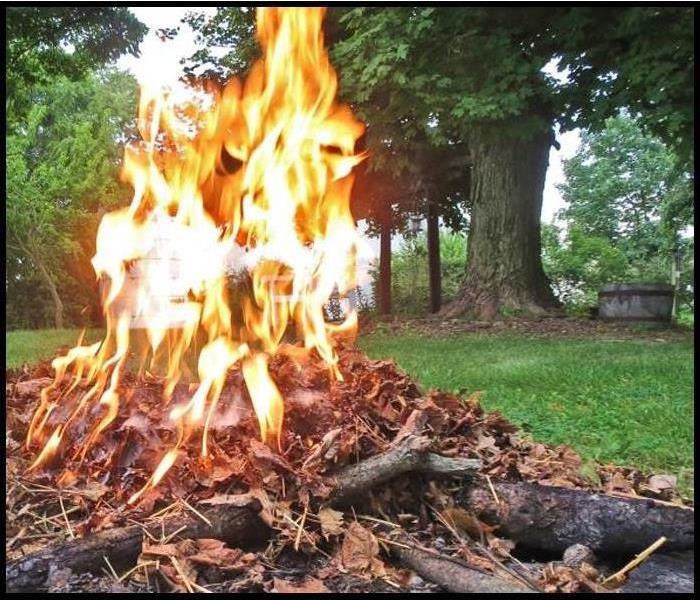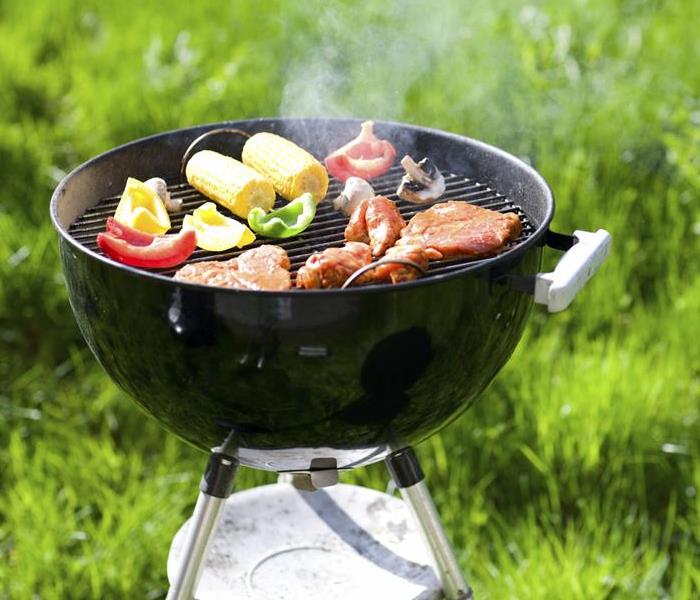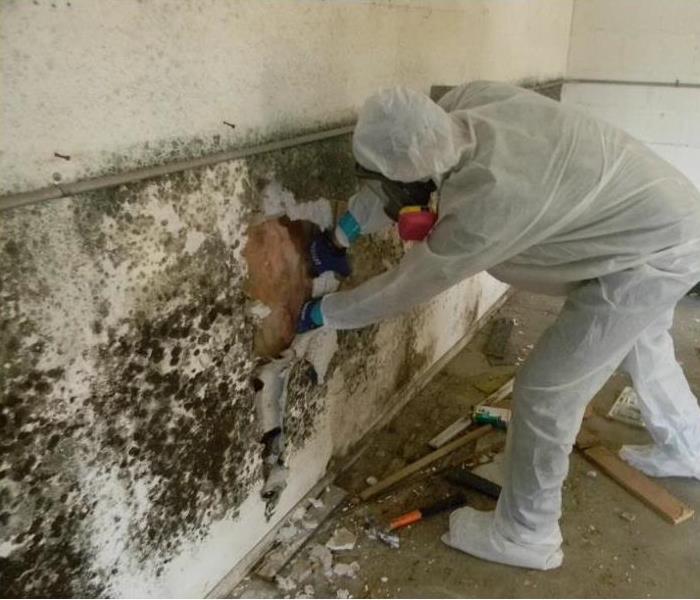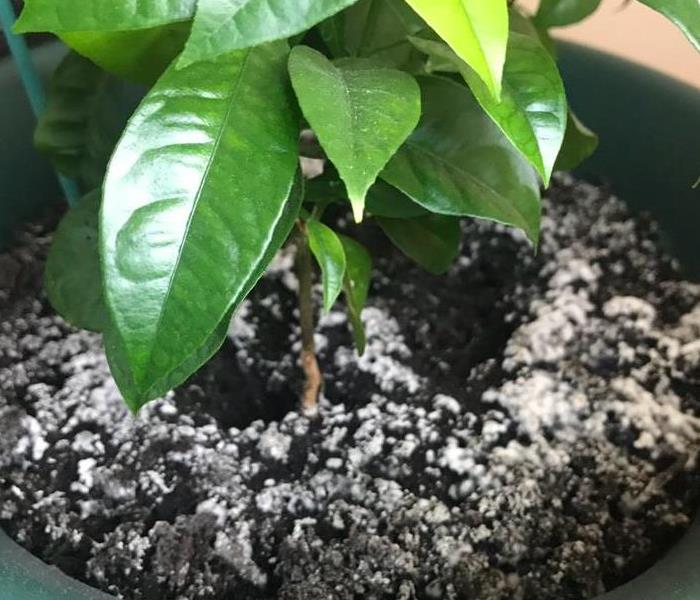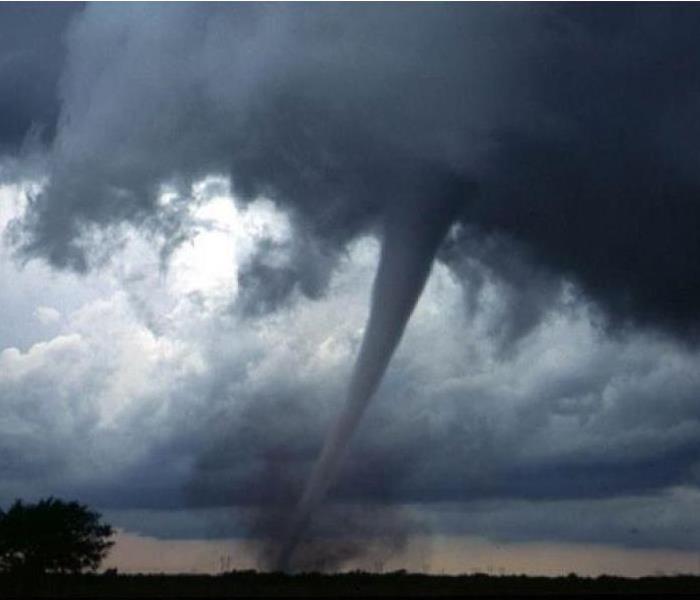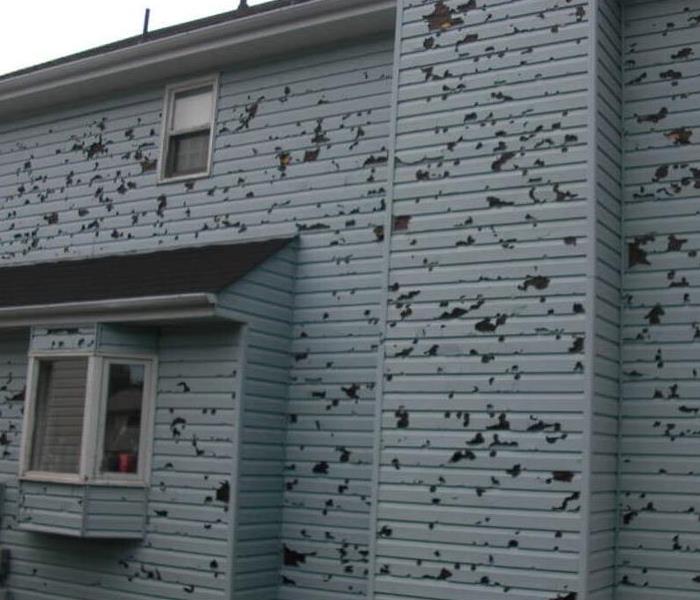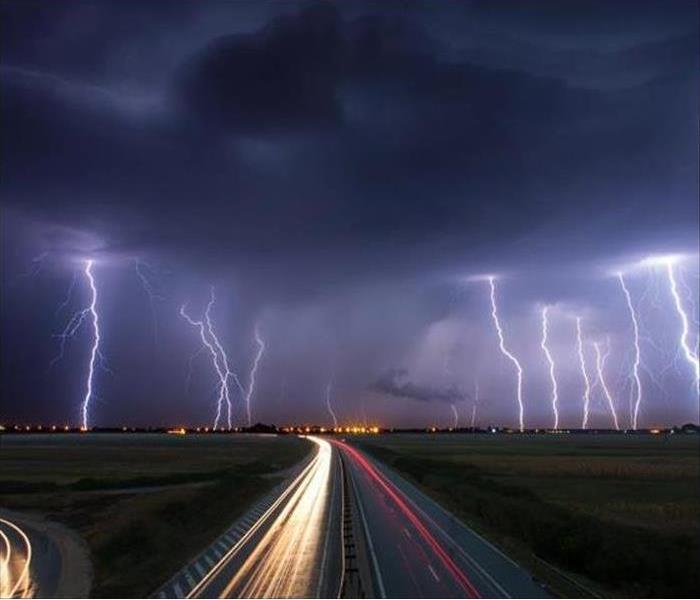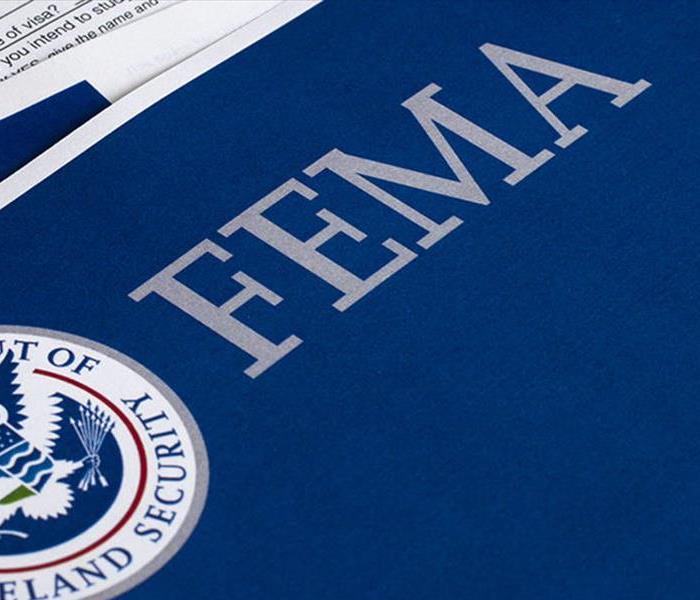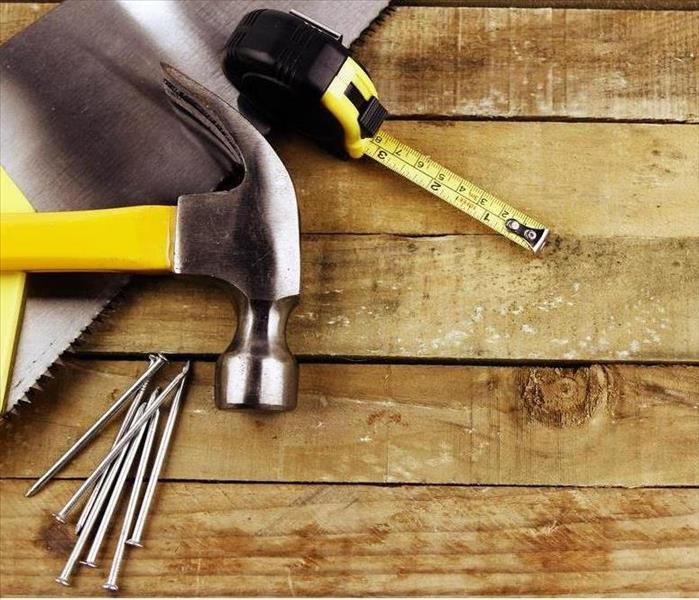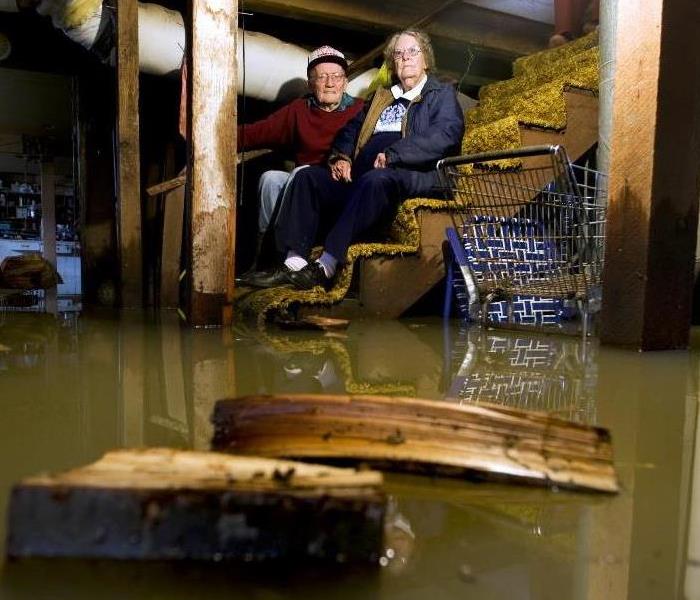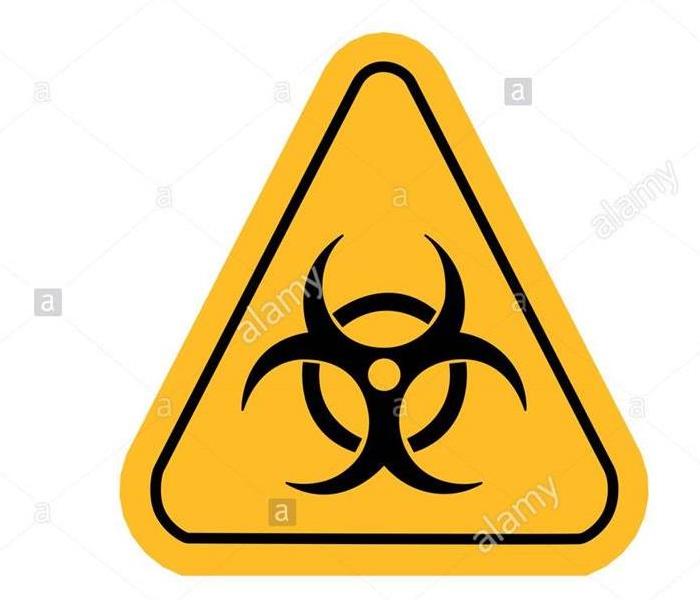Archived Blog Posts
Is Your Business Prepared For Freezing Weather
1/31/2022 (Permalink)
 A burst pipe caused this business to flood, Drying Equipment set to help start the drying process
A burst pipe caused this business to flood, Drying Equipment set to help start the drying process
Over time Plumbing can become weak and wore down. Sometimes the insulation around the pipes may not be as efficient as it once was. If this should happen and plumbing happens to be on an exterior wall, it can lead to a frozen pipe and once the temperature rises, it can burst, causing water to go everywhere. It does not take a big crack in a pipe to allow gallons and gallons of water to come out. Damage that can happen from this can be as small as some flooring that needs to come to multiple floors of flooring, walls, insulation and ceilings that need to come out and be repaired.
If this loss should happen to you, call SERVPRO of Mt Pleasant, Clare and Houghton Lake. We have the experience and know how to get you dried out and get your doors back open quicker. We understand that the longer it takes to get the water dried out, the longer it can take to get back to business.
Boiler Failure
1/31/2022 (Permalink)
 Water Stained Walls from a Boiler Loss
Water Stained Walls from a Boiler Loss
Is your home or cabin's heating sources properly maintained?
It is important to have them properly maintained to avoid failure that can lead to water damage. The latest scenario is from a second home where the boiler failed. The water lines running through the baseboard heat froze during the cold, winter months Michigan is known for. Once temperatures rose and the pipes thawed, they split in a few different locations causing water to spill from the second floor all the way down to the crawl space affecting every room in the house. Due to this being a second home, the homeowner was not there at the time and was not able to turn the water off in a timely manner. The condensation from this caused the insulation in the walls to become soaked along with the river of water that was coming out of their crawl space.
SERVPRO of Mt Pleasant, Clare and Houghton Lake was able to get out to the property and get the water extracted and the walls opened up to allow the condensation to evaporate to limit further damage.
Are you Prepared for Winter
10/4/2021 (Permalink)
This time of year brings Football, Cooler Temps, Leaves changing colors and Pumpkin Spice is back in season. Once all of this happens its a great reminder to make sure your home is ready for the freezing temps and snow to start. Here is a list of things to help be ready for the Winter season:
1) Check your homes heating system. Don't get caught in the cold when a simple check up could have noticed something simple to fix. Routine check up on your homes heating and air conditioning can help avoid more costly repairs down the road
2) Seal masonry and hard surfaces. Look for any daylight that may let in cold air and moisture and seal them.
3) Clean your chimney and order firewood. If you are going to use wood to help heat your home there is probably nothing more important to then making sure your chimney is ready to go.
4) Clean your Gutters and Drains. If there is an ice build up in your gutters this can lead to ice build up on your roof. This can create future damage on your rood and can also melt the ice into your walls.
5) Test your smoke and carbon monoxide detectors. This is a good practice to have throughout the year and not just in the winter months.
How to Keep Mold and Mildew Away
9/15/2021 (Permalink)
Most of of us experience humidity either in our homes, places of Business, Rv's and even in Boat cabins. When high levels of Humidity are present, microbial growth can also take place. Mold and Mildew can grow where there is moisture, low sunlight and poor ventilation. Here are some ways to help keep those conditions low:
Keep humidity levels low ( between 30%-50%) as you can. Air conditioners and dehumidifiers can help keep these levels low.
Be sure that you have enough ventilation. Exhaust fans that vent to the outside of your home or business.
Fix any leaks in your roof, windows and walls that you can, so that mold doesn't have a chance to start growing.
Try not to use carpet in areas that may have higher moisture or humidity levels such as in a basement. Carpet can hold moisture and create a good environment to have microbial growth.
If you feel like you may have a mildew smell or can see something that looks discolored call the experts at SERVPRO of Mt Pleasant, Clare and Houghton Lake at 989-775-5065 or visit us online at www.SERVPROofmtpchl.com
Water Backup from Power Failure
9/15/2021 (Permalink)
Over the past few months we have seen many homes around the area have water damage due to an extended power outage. Many of these backups have come from a Sump Pump failure and even when backups are put into place. What has ended up happening is that when power is out for a long period of time and it continues to rain, the battery backups run out of power as well causing the water to back up into the basement.
If something like this should happen at your property, you can rest assured that SERVPRO of Mt Pleasant, Clare, and Houghton Lake can assist you in getting your home dried out with the industries latest techniques and equipment.
Hurricane Season
6/1/2021 (Permalink)
Today, June 1st, marks the first day of Hurricane Season and extends through November 30th. Experts predict in 2021 there could be 13-20 storms that will be named ( winds of 39mph and higher) and of those, 6-10 could be named Hurricanes and 3-5 major Hurricanes.
Predictions this year will be that warmer then avg surface temperatures and weaker tropical Atlantic trades winds will help fuel more storms this year.
In 2020 SERVPRO of Mt Pleasant, Clare and Houghton Lake jumped into action to help in two States , Pennsylvania and Louisiana, for three Hurricanes.
This is the time to start preparing for residents along the coast as we come into Hurricane Season and here at SERVPRO of Mt. Pleasant, Clare, and Houghton Lake we are always prepared to go where we are needed in a moment's notice.
Cottage Season
6/1/2021 (Permalink)
 Wet insulation from a water soaked crawl space
Wet insulation from a water soaked crawl space
The Unofficial start to summer, Memorial Day Weekend. Many of us travel to our favorite lake cottage or cabin. But what do you do when you walk in and discover that a pipe had burst and there is standing water all throughout your second home? This happened to a cottage owner as they came to check on their property and saw 2-3 inches of water in their cottage and a flooded crawlspace. SERVPRO of Mt. Pleasant, Clare, and Houghton Lake started taking care of the property right away by removing the insulation in the crawl space, removal of tile on the main floor and drying.
Call the professionals at SERVPRO of Mt. Pleasant, Clare, and Houghton Lake at 989-755-5065 to help get your property back in order.
Unlikely Causes for Fire Damage
6/1/2021 (Permalink)
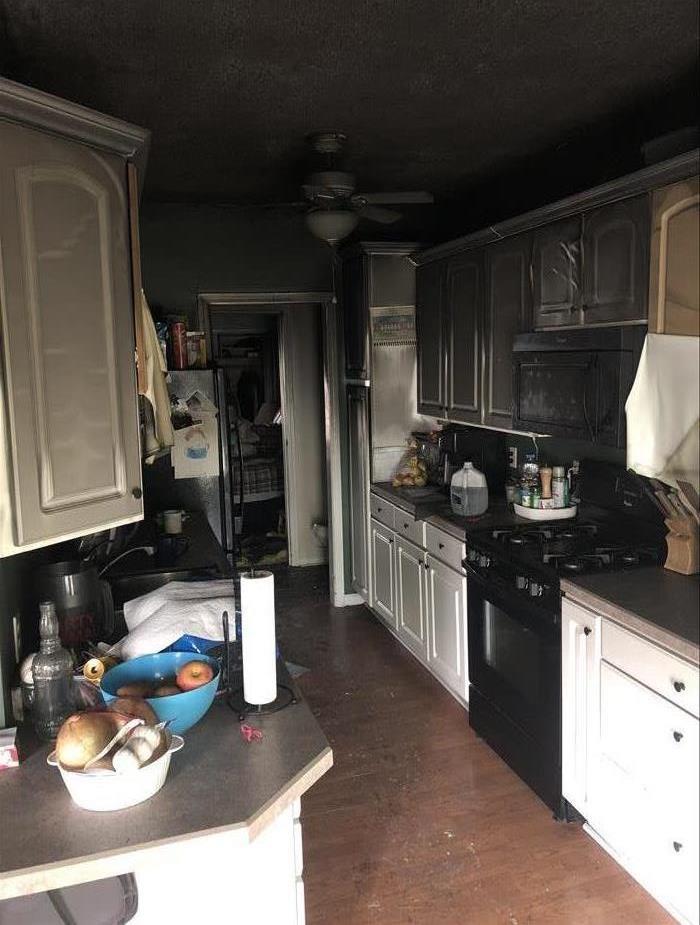 Fire damage
Fire damage
Fires can start from a number of different reasons, leaving a candle burning, a cookie sheet in the oven while it’s preheating and even charging a phone or battery pack and much more.
If any of these unfortunate events should happen to you it is important to call your local SERVPRO in Mt.Pleasant, Clare, and Houghton Lake at 989-775-5065
Recently a household had fire that was not expected while a device was charging. Luckily no one was seriously hurt and was able to get out. SERVPRO of Mt Pleasant, Clare and Houghton Lake was called and able to take care of the damage and get the family back into their house. The family was very happy with the team at SERVPRO made them feel at ease and comfortable with the process.
Apartment Complex
6/1/2021 (Permalink)
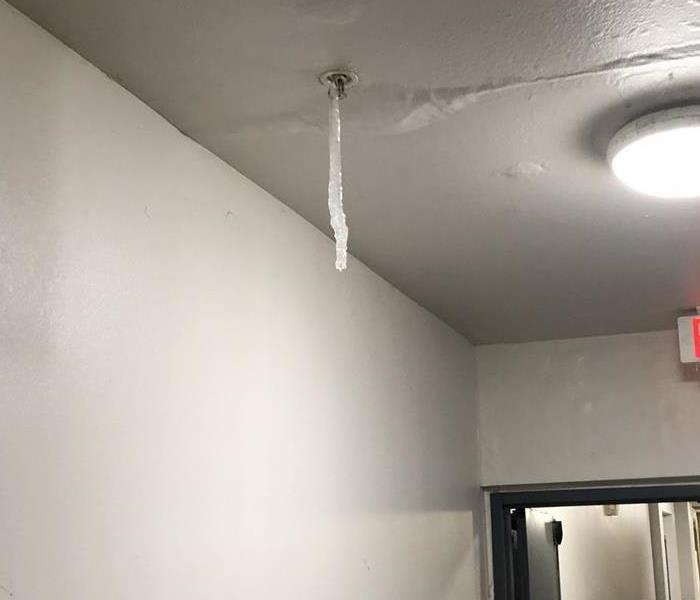 Ice forming from a broken sprinkler line
Ice forming from a broken sprinkler line
Winter Storm Uri hit several areas in the south in 2021 causing an unprecedented amount of damage to residents and businesses throughout the area. SERVPRO of Mt.Pleasant, Clare and Houghton Lake was able to pack up and head south while most of the region was covered in snow and ice and still facing record low temps. A 250 unit apartment complex was one of many buildings that experiences frozen and busted pipes after it had experienced power outages. We assisted in the tear out and helped out many of the residents get the water damaged materials out and on their way to being back into their residences. The residents of Texas were very appreciative that we would come all the from Michigan to help and we were glad that we able to help with the situation that they were in.
When Frozen Pipes Burst, Now What?
2/11/2021 (Permalink)
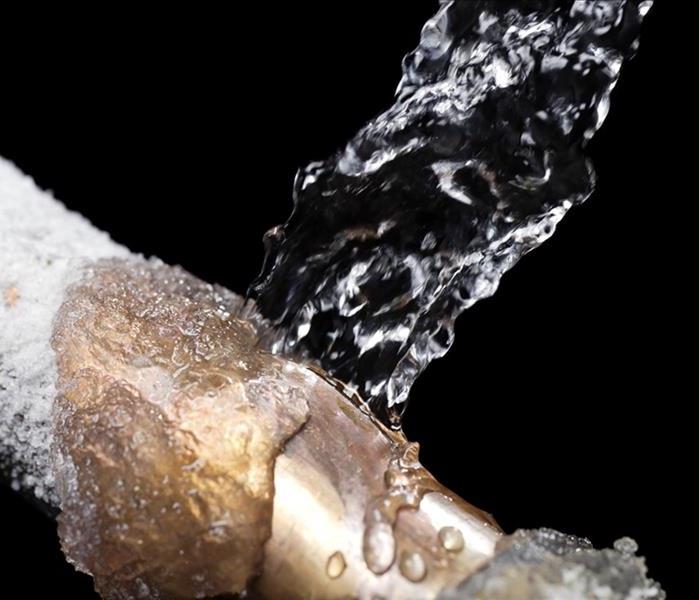 A frozen water line that froze and split causing a leak
A frozen water line that froze and split causing a leak
Sub zero temps have hit most of Michigan the last few weeks and with the bitter cold, it also brings freezing water lines. We see losses occur most of the time with second homes, cottages and maybe a vacant home that is for sale. It doesn’t take long for a pipe to freeze, then have a rapid warm up to thaw the pipe and unfortunately find out that it broke. Some times it can be as small as a pin hole that has had water dripping constantly or could be gushing water once it thaws. No matter the size, the damage it can be extensive if not found and taken care of in a timely matter.
Picture this, you walk into your cottage and find that you had a frozen pipe and it burst, what do you do now ?
1) Find the main water line and turn it off
2) Call SERVPRO of Mt Pleasant, Clare and Houghton Lake at 989-775-5065
3 Get in touch with a plumber and have them look over all your pipes to make sure there are no other broken pipes
What is in your Ready Plan?
1/27/2021 (Permalink)
 Emergency Ready Profile
Emergency Ready Profile
Many businesses have some sort of plan in place to give them and their employees an outline of what to do in case of a catastrophic event such as a tornado, hurricane, fires,etc. But does your business have something it’s plan for a failed pipe, or backed up sewer line,etc. Companies do not think of these things and are typically the items we do see.
SERVPRO of Mt Pleasant ,Clare and Houghton Lake can help provide this FREE plan for you. With our Emergency Ready Profile ( ERP) we will gather all the information needed and keep it in our file so when an event does happen we are already prepared with all important information needed. This allows us to get into your business faster and able to get it cleaned up!
Call 989-775-5065 or visit us at www.SERVPROofmtpchl.com to set up a time for your Emergency Ready Profile
Are You Using the Latest Technology to Disinfect?
1/20/2021 (Permalink)
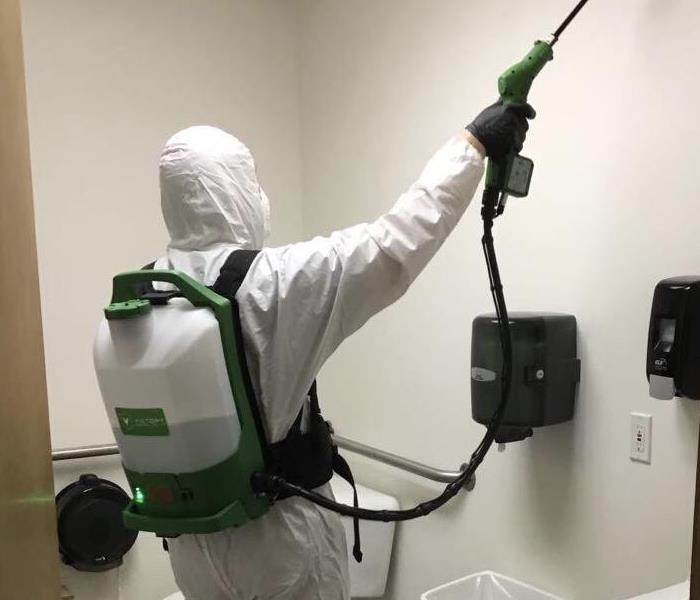 SERVPRO Tech disinfecting with an electrostatic sprayer.
SERVPRO Tech disinfecting with an electrostatic sprayer.
The past year we have all learned new ways to clean and disinfect, how often it should be done, how long it can take and how expensive it can be. Viruses can live on hard surfaces for days and be easily transmitted.
With many of our businesses and schools opening back up, more and more people will be coming through the doors and the chances for viruses to spread will also rise. Do you have a plan? How often will you disinfect? How often can you disinfect? How much will this cost? SERVPRO of Mt Pleasant, Clare & Houghton Lake can help you with all of these questions. We use an electrostatic sprayer that allows us to disinfect more area in less time with less product. How the electrostatic sprayer works is that when the disinfectant exits the sprayer, it does so with a positive charge. The disinfecting agent is now attracted to all negative surfaces and will spread around all visible areas. When the positively charged disinfecting agent droplets come in contact with each other, it naturally moves away from each other creating the spread of the disinfecting agent, covering more area and creating a more uniformed application. We use EPA approved disinfectants that are used in the restaurant and medical fields and our customers can be back in the area that was sprayed within 10 minutes. Because of this new and effective technology, many businesses are adding this to their readiness and cleaning guidelines. It is very important that when using this that the individuals that are spraying are highly trained and compliant with the Centers For Disease Control guidelines. Call SERVPRO at 989-775-5065 or visit us at www.SERVPROofmpchl.com to set up your readiness and cleaning plan
Icicles, a beautiful winter sight or a sign of damage
1/19/2021 (Permalink)
Icicles are a sign that winter is here, they are nice to see but is it also a sign of potential damage?
Once you see icicles forming this could be a sign that ice dams are forming and can lead to further damage if not taken care of quickly.
Ice dams form because there is not adequate insulation in the attic. The warm air tries to escape through the roof and begins to melt the snow, as the water makes its way down to the edge of the roof it freezes causing an ice dam. We also see ice dams form when there is drastic temperature change from cold to warm and back to cold. The ice can damage gutters, shingles, and cause water damage in your house. Water can enter through your walls, into your insulation and if left long enough can cause microbial growth.
If you notice water damage call your local experts at SERVPRO of Mt. Pleasant, Clare and Houghton Lake at 989-775-5056 or visit us at SERVPROofmpchl.com
Categories of Water Damage
5/1/2019 (Permalink)
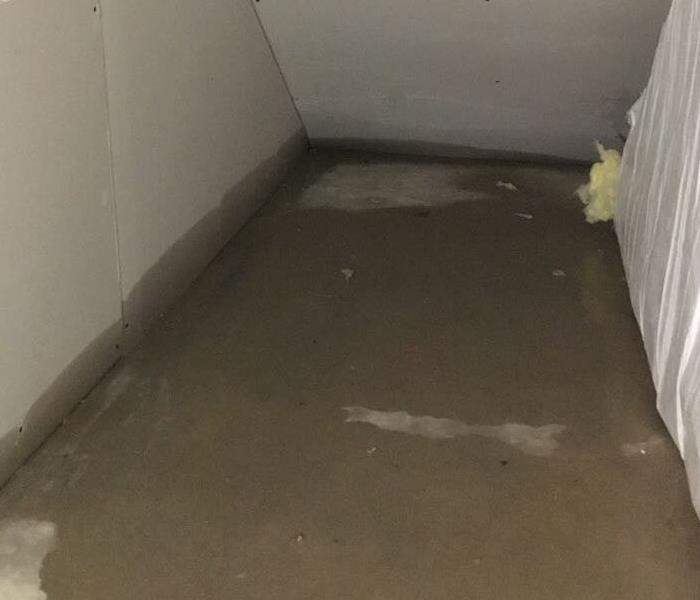 Water damage wicking up the drywall after a sump pump failure.
Water damage wicking up the drywall after a sump pump failure.
You may have had a small roof or plumbing leak. A bath tub overflow. A ruptured water heater. Or major storm flooding.
The amount of water is only part of the water-damage equation. The potential for deterioration and the extent of drying measures also depend on the rate of soak-in, the duration of exposure, and the rate of evaporation. And those in turn depend on the area and type of materials affected.
When moisture lingers for more than a day carpet, furniture, and building surfaces typically develop mold. Soon drywall swells and crumbles, wood swells, warps, and splits. Metals corrode. And given time even concrete weakens. So damage can range from minor discoloration all the way to structural problems. With SERVPRO the emphasis is on prevention and mitigation. Problems can become significant within 24-72 hours, so our focus is on getting things significantly dryer if not completely dry within that time frame.
IICRC Classes of Water Damage
The ANSI/IICRC S500 Standard and Reference Guide for Professional Water Damage Restoration is the gold-standard for the cleaning and restoration industry. It presents practical guidelines and procedures based on science and extensive experience. We talked about their categories of health hazards and the needs for surface cleaning and disinfecting before. Let’s now cover the degrees of leaks, spills, and water intrusions and their potential for damage. The IICRC divides them into four “classes.” It doesn’t giving any specific amounts of water as many other variables go into determining the proper water restoration measures.
Class 1
This class involves the least amount of water. It’s defined as affecting only part of a single room, with minimal wet carpet and affecting only low-permeable materials such as plywood and concrete sub-flooring. Resulting from things such a roof leak and rowdy kids in the bath tub, there’s minimal absorption and little moisture remaining after bulk water removal. So after mopping and blotting a natural slow rate of evaporation may be acceptable. Lifting carpet speeds drying and lets you determine if the sub-floor is excessively damp.
Class 2
Here there’s more water, and more gets absorbed by building materials. It’s defined as affecting an entire room or resulting in large areas of wet carpet, with water wicking upwards in walls at least 1 foot (but less than 2 feet) and moisture reaching structural materials. Class 2 water intrusions require bulk water removal, surface water extraction, and dehumidification for faster evaporation.
Class 3
With the most water and greatest absorption involved, Class 3 water restoration requires the fastest evaporation to head off deterioration. It’s defined as having flooring, sub-flooring, walls, and insulation saturated. With a source above the ceiling, that may be saturated as well. Advanced drying and dehumification methods via specialized equipment are critical.
Class 4
This last class is a special situation, typically the result of heavy natural flooding. There’s been enough water and time to saturate materials such as stone, concrete, brick, and hardwood. Highly aggressive methods to maintain very low specific humidity for longer periods than usual are required. Or the affected rooms may be considered a total loss if the structure has been severely compromised.
If you find yourself in need of a Certified Restoration Service to see our crew click here https://www.SERVPROmountpleasantclarehoughtonlake.com/employee-photos SERVPRO of Mount Pleasant, Clare and Houghton Lake are only a phone call away. We have a Representative available 24/7 to assist you in your time of crisis. Contact us @ 989-775-5065.
Hurricane Florence hits Topsail Island
4/30/2019 (Permalink)
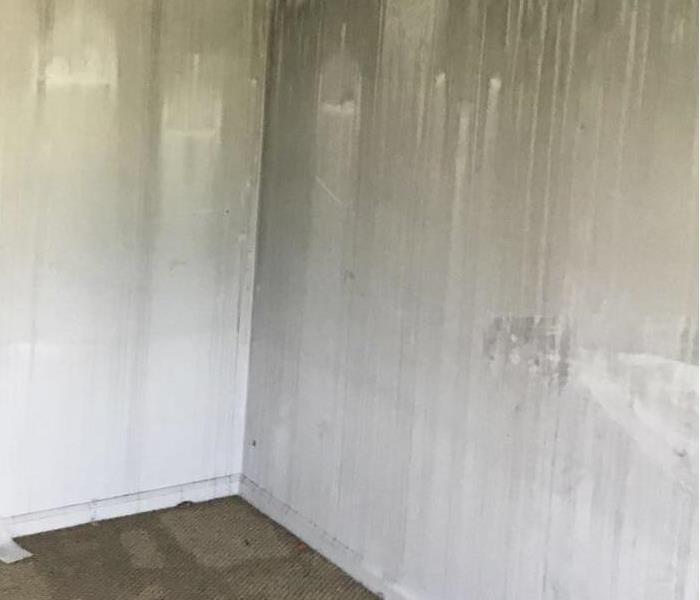 Walls destroyed by hurricane Florence
Walls destroyed by hurricane Florence
SERVPRO of MountPleasant, Clare & Houghton Lake specializes in storm and flood damage restoration. Our crews are highly trained and we use specialized equipment to restore your property to its pre-storm condition.
Faster Response
Since we are locally owned and operated, we are able to respond quicker with the right resources, which is extremely important. A fast response lessens the damage, limits further damage, and reduces the restoration cost.
Resources to Handle Floods and Storms
When storms hit Topsail Island, we can scale our resources to handle a large storm or flooding disaster. We can access equipment and personnel from a network of 1,950 Franchises across the country and elite Disaster Recovery Teams https://www.SERVPROmountpleasantclarehoughtonlake.com/storm-flooding-restoration that are strategically located throughout the United States.
Have Storm or Flood Damage? Call Us Today
989-775-5065
Are you seeing signs of mold in your home or business?
4/29/2019 (Permalink)
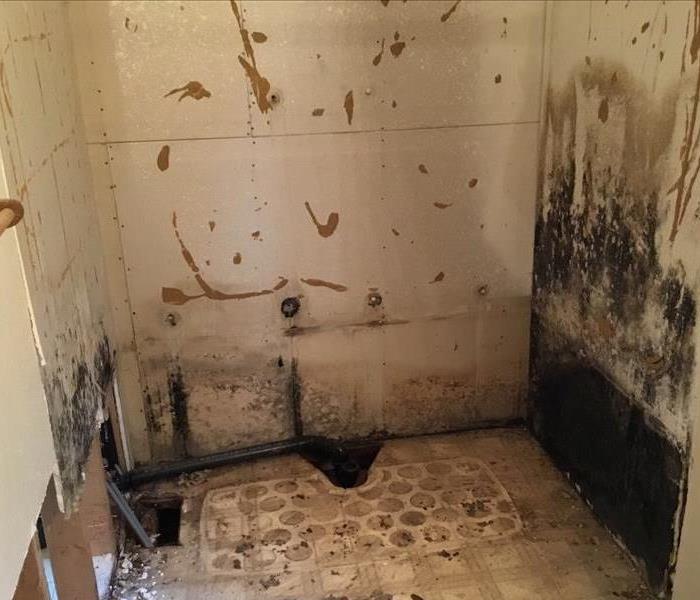 Mold found behind a shower surround.
Mold found behind a shower surround.
Microscopic mold spores naturally occur almost everywhere, both outdoors and indoors. This makes it impossible to remove all mold from a home or business. Therefore, mold remediation reduces the mold spore count back to its natural or baseline level. Some restoration businesses advertise “mold removal” and even guarantee to remove all mold, which is a fallacy. Consider the following mold facts:
- Mold is present almost everywhere, indoors and outdoors.
- Mold spores are microscopic and float along in the air and may enter your home through windows, doors, or AC/heating systems or even hitch a ride indoors on your clothing or a pet.
- Mold spores thrive on moisture. Mold spores can quickly grow into colonies when exposed to water. These colonies may produce allergens and irritants.
- Before mold remediation can begin, any sources of water or moisture must be addressed. Otherwise, the mold may return.
- Mold often produces a strong, musty odor and can lead you to possible mold problem areas.
- Even higher-than-normal indoor humidity can support mold growth. Keep indoor humidity below 45 percent.
If your home or business has a mold problem, we can inspect and assess your property and use our specialized training, equipment, and expertise to remediate your mold infestation.
If You See Signs of Mold, Call Us Today
SERVPRO of Mt. Pleasant, Clare, & Houghton Lake
Mt. Pleasant, Clare & Houghton Lake 24 Hour Emergency Water Damage Service
4/24/2019 (Permalink)
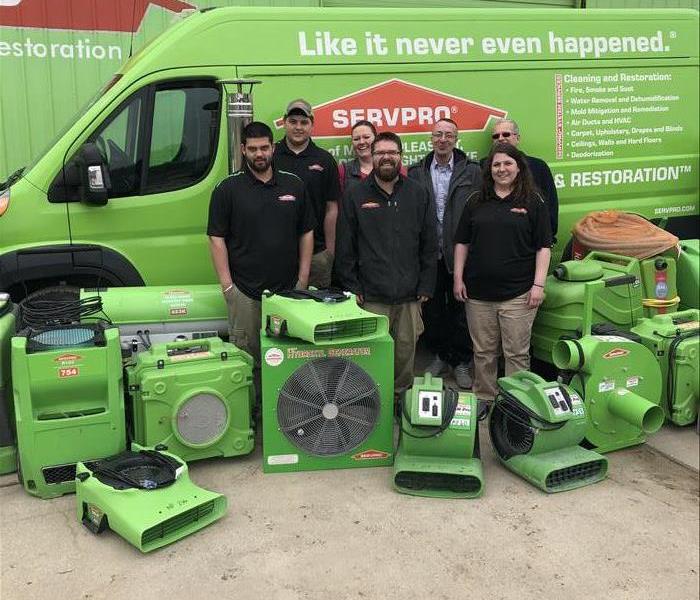 The crew here at SERVPRO of Mt.Pleasant, Clare, & Houghton Lake
The crew here at SERVPRO of Mt.Pleasant, Clare, & Houghton Lake
SERVPRO of Mt. Pleasant, Clare, & Houghton Lake is available 24 hours a day for water emergencies, large or small. When you are dealing with water damage, immediate action is crucial. A delay of just a few hours can greatly increase the severity of the water damage.
We Answer the Phone Ready to Help
Call Today - Mt. Pleasant, Clare, & Houghton Lake (989)802-9126
We understand that when you call us, you may be feeling confused, stressed, and vulnerable. You need an expert to guide you through this crisis. SERVPRO of Mt. Pleasant, Clare, & Houghton Lake has the specific water damage training and experience to help you through this tough time. We specialize in water damage restoration—in fact, it's the cornerstone of our business.
What to Expect
When you call, we will ask several questions regarding your water damage emergency. These questions will help us determine what equipment and resources to bring, including how many trained SERVPRO Professionals may be needed.
Our SERVPRO Representative will ask several questions:
- Your name and contact information
- Your insurance information (if applicable)
- The street address of the water-damaged home or business
- When did the flooding or water damage occur?
- What caused the water damage (if known)?
- Is there electricity available (on-site)?
Not All Water Damage Is Created Equal
4/28/2018 (Permalink)
How many of you remember as a kid playing in or around storm water drains or roadside ditches? It was fun, right? While you may have enjoyed splashing around in the waters, you might not realize that storm water like this may actually be contaminated with raw sewage, dangerous chemicals, or harmful bacteria and viruses capable of transmitting dangerous diseases to you.
In this same way, the harmful water that invades your home following a broken pipe, clogged toilet overflow, leaking dishwasher, overflowing washing machines, leaky roofs, or even foundation crack can be harmful.
Restoration Depends on Water Type
Specific steps must be taken to reduce property destruction, depending on the type of water damage. According to the Institution of Inspection Cleaning and Restoration Certification (IICRC), who sets the standards for the cleaning industry and water damage restoration training, there are three levels or types of water involved in damages. They include:
Category 1: Clean water
This water damage is from sanitary sources, such as an overflowing sink or tub, burst water pipes, failed supply lines to appliances, drinking fountains, or vertical falling rainwater.
Category 2: Grey water
This water is from sources that could make you uncomfortable or ill if ingested. Washing machine, dishwasher, or urine-tainted toilet overflows belong in this category.
Category 3: Black water
This is the worst classification of water and could cause severe illness if ingested. Sewer backups, flooded rivers, feces-tainted toilet overflows, or stagnant liquid that has bacterial growth are all examples of black water.
Let the Experts Save Your Home and Belongings
Seeping water damage is progressive, pervasive and can mean valuable objects or keepsakes may become permanently damaged. The professionals you find at a local SERVPRO are trained on how to handle the various types of water damage. Once they arrive on the scene at a home or business, they quickly assess the situation and start the restoration process in these three areas:
- Aggressive cleaning: Wall cavities and other surfaces are pressure washed with a detergent solution. Salvageable materials are flushed and thoroughly disinfected.
- Moisture detection: Not all water damage is visible to the naked eye. Water trapped in structural cavities may require sophisticated detection equipment to mitigate odors, prevent mold growth and minimize structural damage.
- Rapid Structural Drying: Mold begins growing on soggy surfaces within only 24 to 48 hours. Rapid drying, all the way down to the building’s substructure, is necessary to restore pre-flood conditions.
After your home floods, you may think your home and its contents are beyond hope, but many of your furnishings and belongings can be restored. With SERVPRO Of Mt.Pleasant, Clare and Houghton Lake's help, your flooded home can be cleaned up, dried out, rebuilt, and reoccupied sooner than you think.
If you find yourself dealing with water damage contact SERVPRO of Mt.Pleasant, Clare and Houghton Lake @ 989-775-5065 24/7 one of representatives are standing by.
Spring Time Means it's The Start of The Rainy Season.
4/28/2018 (Permalink)
Spring is finally here. Flowers are starting to bloom, but it also means it’s the start of the rainy season. While the spring can bring welcome relief after the long winter months, flooding is a real concern for homeowners. You don’t need to live in a flood zone to fall victim to flooding. It’s best for everyone to be prepared in case the worst happens.
While those in flood zones are more likely to experience some level of flooding, the reality is that it could occur anywhere. Changes in the area could create flood zones in areas that were deemed safe in the past and major weather storms could cause severe flooding that extends into zones that aren’t used to experiencing the flooding.
All homeowners should take the time to make sure they’re prepared just in case anything happens. It’s important for them to make sure they understand what can be done to prevent serious flood damage inside homes and to protect their belongings from these issues. Along with this, they’ll want to make sure they can prevent as much damage as possible to protect their family from safety issues that could occur if the home is flooded.
Know Your Risk Before Spring Begins
Even though a homeowner might have checked to see if they were in a flood zone when they initially bought the home and purchased homeowner’s insurance, it’s a good idea to recheck this occasionally. Flood zones can and do change. With growing cities, the arrangement of new homes and businesses could lead to a change in the areas that might be considered flood zones and could lead to more flood zones being created. Homeowners should make sure they know whether their home is now in a flood zone to ensure they can take the proper precautions if anything has changed since they bought the home.
Homeowners will also want to make sure they check the expected flood levels. This will give them a better indication of how high the flood waters could get in their home, so they can make sure anything important is above this level. Many homeowners will want to have their furnace, water heater, and other equipment inside the home placed above this level to minimize damages if flooding does occur.
Prepare with Building Supplies and Sandbags
Sandbags can often be obtained nearby when there is the potential for a flood, but the lines to obtain sandbags can be long and the amount a family can take for their home may be limited. Homeowners can keep their own sandbags on hand to use if there is a threat of flooding in their area. The sandbags should be placed where needed to help keep flood waters from getting into the home when there is a chance of flooding.
Along with purchasing and preparing sandbags, homeowners can purchase building supplies to keep on hand. It’s a good idea to secure these up and out of the way in case flooding does occur. Having a few stud boards, plywood boards, tarps, nails and more on hand can help with emergency repairs if there is the potential for flooding or help create a way to protect some of the items in the home from damage. Additionally, there could be a shortage of building supplies in the immediate aftermath of the flood, so having these supplies on hand could lead to faster repairs if anything is damaged.
Keep Important Documents and Irreplaceable Items Above Flood Levels
Homeowners who know their flood levels will want to prepare by placing any irreplaceable documents or items in boxes that can protect them. These boxes should be placed above the potential flood levels but should be easy to grab in case of an evacuation. This will help homeowners ensure identifications, passports, deeds, insurance documents, and more are both safe from the flood and easily accessible if a flood does impact the home or an evacuation is necessary.
Prepare an Emergency Plan in Case Flooding Occurs
Families should always have a plan in place to deal with potential natural disasters, and flooding is no exception. Even if the home is in an area that is not likely to flood, parents will want to speak with their children about what could happen in a flood, what they should do, and how they can stay safe. This should include how to prevent injuries or illnesses from contaminated flood water as well as what to do if an evacuation is needed and what should be grabbed from the home if they need to evacuate.
Act Fast to Minimize Damage After a Flood
If a home is impacted by a flood, the first step will be to assess the damage and remove all water from the home. This can be done by SERVPRO to ensure it’s done properly. At this point, the homeowner will want to start removing anything damaged from the home and repairing anything that needs to be repaired. Flood waters, even after the majority is removed from the home, could cause mold growth because of the water that was inside the home and that soaked into the building materials.
The faster the home is repaired, the lower the chance for mold to grow. Additionally, the damage from the water won’t have the chance to spread to more areas of the home if it’s removed as quickly as possible. The emergency building supplies purchased before the chance of flooding could help the homeowner repair their home faster and enable them to minimize the potential damage that could occur while they wait for help with larger repairs.
Spring can be the start of beautiful weather and a welcome change from the dreary winter, but it can also bring significant flooding to many areas. Homeowners can use these tips to ensure they’re prepared for flooding and know how to protect their home, belongings, and family from any potential floods. Start preparing your home today to ensure you and your family are as safe as possible in case anything happens.
If you find yourself in the need of a Water Restoration Company, SERVPRO of MT.Pleasant,Clare and Houghton Lake are here to assists you 24/7. Simply call 989-775-5065 and one of our Representatives will be glad to help.
May is Mobility Awareness Month
4/28/2018 (Permalink)
Since 2012, May has been recognized as National Mobility Awareness Month, sponsored by the National Mobility Equipment Dealers Association (NMEDA). Driven by the theme “Life Moving Forward,” NMEDA members and industry partners team up to organize an international campaign that works to highlight and celebrate the ways in which people living with disabilities persevere and triumph over their physical challenges while bringing attention to the many life-changing mobility solutions available to make independence more accessible.
People with disabilities constitute the second largest minority in the United States. In the United States and Canada, over 18 million people have mobility issues, six million of whom are veterans. NMEDA wishes to draw awareness to the fact that there are mobility equipment manufacturers, dealers, driver rehabilitation specialists and other professionals in every community dedicated to improving the lives of people with disabilities. Automotive mobility solutions are available for people with disabilities enabling them to enjoy active, mobile lifestyles.
Resources:
http://www.nmeda.com/mobility-awareness-month/
https://www.facebook.com/pg/NationalMobilityAwarenessMonth/about/
http://mobilityawarenessmonth.com/
Four Causes of Commercial Fires
4/23/2018 (Permalink)
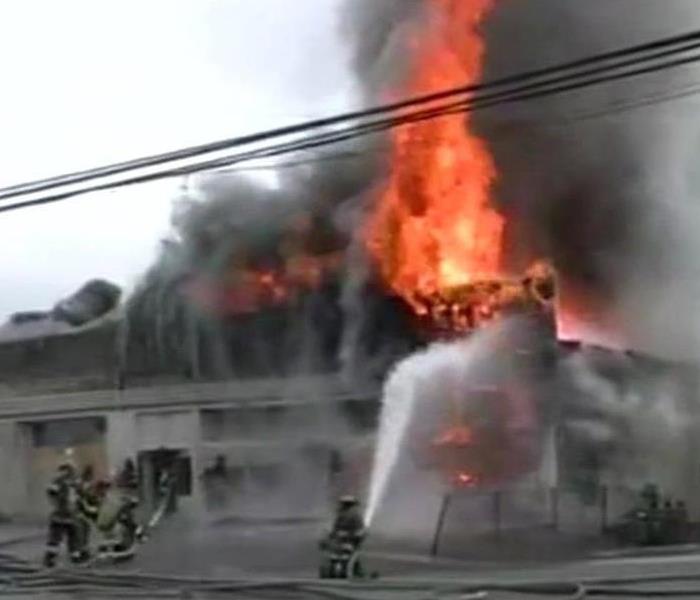 Commercial fire and fire department working on putting it out.
Commercial fire and fire department working on putting it out.
In 2017, a whopping 100,500 Commercial Fires were reported. A large number of these fires resulted in injuries, loss of life, and huge monetary losses. Although it is commonly thought that commercial fires are caused by human error, this is not always the case. There are four major reasons that commercial or non-residential buildings go up in flames.
- Electrical Fires – Electrical systems or appliances are all too common causes of commercial fires. Businesses sometimes hire individuals that are not qualified to modify their circuits or electrical outlets. This can lead to a number of problems and code violations, putting people and property in serious danger. The electrical equipment itself has also been known to cause fires when they are overloaded or misused and lacking proper maintenance.
- Arson – As unlikely as it may seem, arson is actually one of the leading causes of workplace injuries, fire damage, and even death in commercial buildings. As it is a fire that is intentionally set to cause damage, arson may lead to a catastrophic loss of life and property. This horrible crime may be an act of vandalism, an act of revenge by unhappy clients or workers, or even instigated by the owner of the property for insurance purposes. It is important to have these situations thoroughly investigated by the proper authorities.
- Boilers, Water Heaters, and Furnaces – While we do not have to worry about furnaces and boilers here in Florida, these three appliances are not always installed according to codes for their installation, maintenance, and use. Improper installation or a lack or maintenance could trigger a fire in your building. Additionally, storing flammable or combustible materials near them could also result in a fire.
- Human Error – While arson is a big problem, not every fire set by humans is malicious – a lot of the time it is an innocent accident. A smoldering cigarette, forgotten coffee pot, or knocking liquids on electrical equipment could all result in an office fire. Those who are negligent in office safety protocol could also start a fire with acts such as stacking or covering electrical equipment or improperly storing flammable items.
Mold Remediation in Schools and Commercial Buildings
4/23/2018 (Permalink)
As the public becomes more aware about the effects of mold exposure, concern about indoor mold has steadily increased. Here are some guidelines for the remediation/cleanup of mold and moisture problems in schools and other commercial buildings. These guidelines serve as a tool to protect the health of building occupants and remediators, and have been designed for:
- Building managers
- Custodians
- Others who are responsible for commercial building and school maintenance
It should serve as a reference for potential mold and moisture remediators. Using this document, individuals with little or no experience with mold remediation should be able to make a reasonable judgment as to whether the situation can be handled in-house. It will help those in charge of maintenance to evaluate an in-house remediation plan or a remediation plan submitted by an outside contractor1. Contractors and other professionals who respond to mold and moisture situations in commercial buildings and schools may also want to refer to these guidelines.
Molds can be found almost anywhere; they can grow on virtually any organic substance, as long as moisture and oxygen are present. There are molds that can grow on wood, paper, carpet, foods, and insulation. When excessive moisture accumulates in buildings or on building materials, mold growth will often occur, particularly if the moisture problem remains undiscovered or unaddressed. It is impossible to eliminate all mold and mold spores in the indoor environment. However, mold growth can be controlled indoors by controlling moisture indoors.
Molds reproduce by making spores that usually cannot be seen without magnification. Mold spores waft through the indoor and outdoor air continually. When mold spores land on a damp spot indoors, they may begin growing and digesting whatever they are growing on in order to survive. Molds gradually destroy the things they grow on.
Many types of molds exist. All molds have the potential to cause health effects. Molds can produce allergens that can trigger allergic reactions or even asthma attacks in people allergic to mold. Others are known to produce potent toxins and/or irritants. Potential health concerns are an important reason to prevent mold growth and to remediate/clean up any existing indoor mold growth.
Since mold requires water to grow, it is important to prevent moisture problems in buildings. Moisture problems can have many causes, including uncontrolled humidity. Some moisture problems in buildings have been linked to changes in building construction practices during the 1970s, 80s and 90s. Some of these changes have resulted in buildings that are tightly sealed, but may lack adequate ventilation, potentially leading to moisture buildup. Building materials, such as drywall, may not allow moisture to escape easily. Moisture problems may include:
- Roof leaks
- Landscaping or gutters that direct water into or under the building
- Unvented combustion appliances
- Delayed maintenance or insufficient maintenance are also associated with moisture problems in schools and large buildings
Moisture problems in portable classrooms and other temporary structures have frequently been associated with mold problems.
When mold growth occurs in buildings, adverse health problems may be reported by some building occupants, particularly those with allergies or respiratory problems. Remediators should avoid exposing themselves and others to mold-laden dusts as they conduct their cleanup activities. Caution should be used to prevent mold and mold spores from being dispersed throughout the air where they can be inhaled by building occupants.
If you believe you have a mold issue please contact SERVPRO of Mt.Pleasant, Clare and Houghton Lake 989-775-5065
COMMERCIAL BUILDING PLUMBING LEAKS THAT COULD CAUSE EXPENSIVE REPAIRS
4/23/2018 (Permalink)
Commercial facilities commonly use a significant amount of water, either through their business processes or simply because there are numerous people using bathroom or kitchen facilities over the course of a day. Water leaks in the plumbing system can substantially increase the company's monthly bills while wasting hundreds or even thousands of gallons of water. Some of the following types of commercial building plumbing leaks could eventually cause expensive repairs. However, if the leaks are caught and fixed early enough, the repairs could be more moderate and less water will be wasted.
Toilet Leaks
Toilets in commercial facilities, especially those with public restrooms, get a substantial amount of use. Even toilets in office facilities that serve only employees will usually be used more than a comparable residential toilet. For this reason, it's vital that toilets be kept in good condition and that leaks are repaired as quickly as possible. If leaks are neglected, they could eventually lead to the need to replace the toilet.
The most common source of toilet leaks is a flapper or tank ball that doesn't seat correctly or a faulty fill valve or ballcock. If the flapper doesn't seal properly, water can leak from the toilet drain. A fill valve that doesn't shut off when the toilet tank is refilled will continue to send water into the tank. This water will be wasted down the drain. Replacing these parts is generally not too expensive, but neglecting the problem can lead to substantial long-term water loss.
Faucet Leaks
Faucet Leaks are also relatively common and are usually the result of a worn or damaged component such as a sealing washer or seat assembly. Rubber washers are used to create a watertight seal in the faucet to prevent leaks. If these washers wear out, or if they are incorrectly sized, the seal will fail and the faucet will leak. Replacing washers is inexpensive, but over time the wear could increase and affect other components, requiring replacement of the entire faucet fixture.
Hidden Leaks
Hidden Leaks in your commercial facility have the potential to create a nightmare scenario of unexpected flooding or long-term water damage that is only discovered after it's too late. Once hidden leaks are discovered, repair may require removing walls, floors, ceilings, equipment or other material to get access to the leak. Repairing damage caused by the leak can be expensive, as could mold remediation or other procedures to decrease long-term problems from the leak.
To help locate hidden leaks, look for signs such as:
- Unexpected or unexplainable increases in your water bills.
- Signs of water damage or water staining along walls, floorboards or other locations.
- Wet floors, carpets, walls or other structures.
Underground Leaks
Leaks in underground water supply pipes, sewer drains or other buried piping systems could lead to expensive repairs. In many cases, these types of leaks will require a visual inspection by remote cameras or other device to pinpoint the location of the leak. When the leak is found, the pipes will have to be dug up and repaired and the displaced soil will have to be replaced. In worse cases, exploratory digging will be required to locate the source of the leak.
Watch for these signs of underground plumbing leaks to help resolve this problem before it becomes a source of expensive repairs:
- Again, unexpected spikes in your water bills could indicate an underground water leak.
- Look for areas of wet soil, which could indicate an underground plumbing leak.
- Check for areas where grass or other vegetation is growing faster than the surrounding areas. This could mean an underground leak underneath the faster-growing plants.
SERVPRO of MT.Pleasant,Clare and Houghton Lake can help repair any damage due to plumbing leaks. Give us a call 24/7 @ 989-775-5065 where you can speak to one of our representative,
Spring is here and the yard work begins.
4/23/2018 (Permalink)
Every spring we get called out to a fire that was started due to burning leaves and in most cases, those fires could have been avoided with some careful planning and a more thought out strategy.
1. Check the conditions.DO NOT BURN WHEN IT IS WINDY.Even a small burst of wind can move a burning leaf and cause a fire. “I didn’t think it was THAT windy,” is not a valid excuse.
2.Never leave the burn pile.You must stay outside and monitor the situation at all times. Murphy’s Law would say that the two minutes you go inside to get a drink is when a small wind will transform your small leaf burning into a full fledge garage fire. Be smart!
3. Be aware of your surroundings. Do not burn near any powerlines or low hanging trees. You need to haveat least three times the height of the pile in vertical clearance.Professionally we would suggest not burning below anything that is hanging. Why risk it?
4. Have a hose and water source nearby. As an extra precaution you can spray the ground around the fire to help keep the area wet and prevent additional spreading.
5.Do not burn everything all at once. This is obviously reliant on what you have to burn and your burn area, but it is always easier to add leaves than it is to take them away. Keep your fire small and add additional leaves as the fire burn down.
6. If using a burn barrel, make sure it is made entirely of metal, properly equipped (at least three evenly-spaced, three-inch holes, screened vent and metal top screen) and in good condition.
7. When complete, drown the ashes with water and use a shovel to carefully turn over the ashes.Drown the fire again and repeat multiple times.The goal is to prevent any sort of rekindling.
If you do decide to burn your leaves this fall, please be cautious and smart. If you have any questions, call your local fire department and ask for guidance. They would be more than happy to help you.
SERVPRO of MT.Pleasant,Clare and Houghton Lake can help repair any damage due to out of control yard fires. . Give us a call 24/7 @ 989-775-5065 where you can speak to one of our representative,
Warmer Weather Brings Out The Grills.
4/23/2018 (Permalink)
It happens every year. The weather gets warmer, more people use outdoor grills – and incidents of grill-caused fires go up. Each year, outdoor grilling causes an average of 8,900 home fires. Listed below are 9 safety tip when Grilling.
1. Grill outside and away from any structures
Charcoal and gas grills are designed for outdoor use only. However, NFPA reports that more than one-quarter (27 percent) of home fires started by outdoor grills began in a courtyard, terrace or patio, and 29 percent started on an exterior balcony or open porch. Pay attention to overhanging tree branches when you set up your grill.
2. Make sure your grill is stable
Only set up your grill on a flat surface and make sure the grill can’t be tipped over. Consider using a grill pad or splatter mat underneath your grill to protect your deck or patio.
3. Keep your grill clean
Remove grease or fat buildup from both the grill and the tray below the grill. If you are using a charcoal grill, allow the coals to completely cool off before disposing of them in a metal container.
4. Check for propane leaks on your gas grill
Before the season’s first barbecue, check the gas tank hose for leaks by applying a light soap and water solution to the hose and then turning on the gas. If there is a propane leak, the solution will bubble. Other signs of a propane leak include the smell of gas near the barbecue or a flame that won’t light.
5. If the flame goes out, wait to re-light
If you are using a gas grill and the flame goes out, turn the grill and the gas off, then wait at least five minutes to re-light it.
6. Take care around the grill
Never leave a lit grill unattended. Don’t allow kids or pets to play near the grill. Never try to move a lit or hot grill, and remember the grill will stay hot for at least an hour after use.
7. Be careful with charcoal starter fluid
If you use a charcoal grill, only use charcoal starter fluid. If the fire starts to go out, don’t add any starter fluid or any other flammable liquids to the fire. Consider using a charcoal chimney starter, which uses newspaper to start the fire instead of starter fluid.
8. Wear the right clothing
Clothing can easily catch fire, so be sure your shirt tails, sleeves or apron strings don’t dangle over the grill.
9. Be ready to put out the fire
Have baking soda on hand to control a grease fire and a fire extinguisher nearby for other fires. If you don’t have a fire extinguisher, keep a bucket of sand next to the grill. Never use water to put out grease fire.
SERVPRO of MT.Pleasant,Clare and Houghton Lake can help repair any damage due to a spark from your grill. Give us a call 24/7 @ 989-775-5065 where you can speak to one of our representative,
Summer Bring Lightning-Related Fires
4/23/2018 (Permalink)
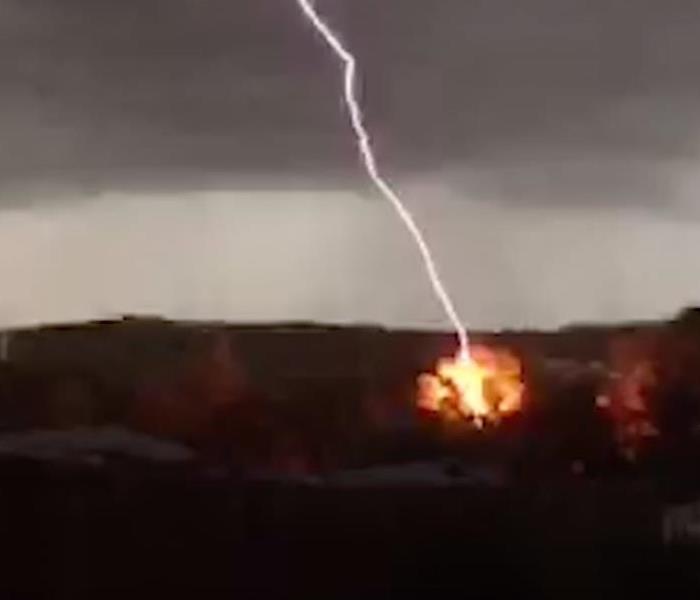
- During 2011-2017, U.S. local fire departments responded to an estimated average of 22,600 fires per year that were started by lightning. These fires caused an average of nine civilian deaths, 53 civilian injuries, and $451 million in direct property damage per year. Most of these fires occurred outdoors, but most associated deaths, injuries, and property damage were associated with home fires.
- Lightning-related fires are more common in June through August and in the late afternoon and evening. Peak seasons for lightning-related fires vary by region, as do weather patterns in general.
- In addition to the fires reported to local fire departments, federal and state wildland firefighting agencies reported an average of 9,000 wildland fires started by lightning to the National Interagency Fire Center per year in 2011-2017. These fires tended to be larger than fires started by human causes. The average lightning-caused fire burned 402 acres, nine times the average of 45 acres seen in human-caused wildland fires.
- In addition to causing fires, lightning is dangerous on its own. Data from the National Weather Service show that in 2011-2017, an average of 29 people per year died as a result of lightning strikes. The most common location for these deaths was outside or in an open area. The average number of lightning flashes per square mile varies considerably by state, as does the death rate from lightning incidents.
SERVPRO of MT.Pleasant,Clare and Houghton Lake can help repair any damage due lightning. Give us a call 24/7 @ 989-775-5065 where you can speak to one of our representative,
Mold Remediation Company Vs. Do-it-Yourself
4/23/2018 (Permalink)
There is often a lot of confusion surrounding the question, “Should I clean the mold up myself or should I hire a mold remediation company?” Some people say that you can clean it yourself with no problem and others state that you should never try to clean it. However, even with all of the confusion, the answer is pretty simple and straightforward. Let’s talk about it!
First Thing’s First
Before addressing the cleaning process, you should first find and correct the cause. Since mold is usually caused by a moisture issue, you should first check for the following moisture intrusion types around the moldy area.
- Plumbing Leaks
- Ceiling Leaks
- Floods / Puddles
- Recent Spills
- Humidifier
These are some common water intrusions that causes mold growth. If you find one of these issues near the affected area, then you may have your cause. The first thing to do if you encounter one of these issues, or any other moisture issue, is to stop it as quickly as possible. If you have to call a professional to come out, ask them for tips to keep the area as dry as possible until they arrive. You should take care of the moisture issue before contacting a mold remediation company because if you get a mold remediation before correcting the moisture issue, mold will likely grow back within a few days.
What if I can’t locate the moisture intrusion?
If you cannot locate the moisture yourself, you should contact a moisture management company. These companies will be able to locate the moisture issue and will likely know what needs to be done to correct them. Usually, these companies will be able to fix the problem themselves, however, if they encounter a plumbing issue that requires professional plumbers, they will likely have some great recommendations.
Mold Remediation Company Vs. Do-it-Yourself
Once you have found and corrected the issue that is causing mold growth, you can decide how to move forward with the removal process. The simple rule to follow when deciding is to measure the moldy area. If you have visible mold and it covers more than 9 sq. feet than you should strongly consider hiring professionals. If the area of visible mold is less than 9 sq. feet, DIY mold removal could possibly work. The reason that I stress “possibly” is because in some cases, there may be invisible or hidden mold. You could also have active growth in other areas of the property without realizing it. If you ever try a DIY process and the mold grows back or mold symptoms consist, consider hiring a mold company for testing and inspection to get a better idea of what’s going that you can’t see.
Mold Remediation Company
So how do you deal with hiring a mold remediation company? The first step is to discover which company best fits the needs of your family. Some remediation methods use strong chemicals that may be harmful if digested by a small child or pet. Since mold grows on just about any type of surface, everything in an affected area will need to be cleaned during a thorough remediation. This includes those small objects that small children or pets may put into their mouths. Always ask companies what type of chemicals they use and the potential dangers.
Do-it-yourself Mold Remediation
A do-it-yourself approach to mold could be a bit more risky for the health of yourself and those around you if you don’t take proper precautions. The first step to protecting the health of everyone is to remove anyone from the property that is a toddler, pregnant, elderly or has a weakened immune system during the remediation. To protect yourself, and anyone that is helping clean the mold, be sure wear appropriate protective gear.
Conclusion
Mold can be stressful. Not only can it affect the health of you and your family, it can also affect your wallet and your home. The most important thing to remember is to always do what’s best for the health of your family no matter how you decide to clean it.
SERVPRO of MT.Pleasant,Clare and Houghton Lake can help repair any damage due to mold issue. Give us a call 24/7 @ 989-775-5065 where you can speak to one of our representative,
Houseplant Mold Removal Tips
4/23/2018 (Permalink)
Houseplants have done a great job over the years at both decorating homes and helping to better the air of homes. Unfortunately, houseplants can also be the source of mold, which does the exact opposite for a home’s air. Since plants require a lot of moisture to survive, it makes them the perfect feeding grounds for mold growth to occur. However, that mold growth can be prevented. In this article, we will discuss some houseplant mold removal and prevention methods.
What Causes Houseplant Mold?
Mold is known to need 3 things to thrive. Those three things are food, oxygen, and moisture. Organic matter, such as the soil and leaves, are some of mold’s favorite foods. Also, plants require water in order to survive – lots of water. This combination of elements makes plants the perfect habitat for mold to grow.
Houseplant Mold Prevention
To prevent active growth in plants, treat them just like any other parts of your home. That is to control the moisture levels. Listed below are mold prevention tips that will lower the chances of houseplant mold.
- Don’t over water: Most houseplants come with instructions to water. Follow these watering instructions for best practices.
- Cinnamon: Cinnamon is a natural, harmless anti-fungal substance. You can prevent mold growth by adding cinnamon to the plant soil.
- Gravel: Adding gravel to the bottom of the soil will help the plant drain more efficiently.
- Ventilation: Make sure your plants are in a well ventilated area. This may be the most important prevention method. Run fans, open windows and run ventilation fans regulary. If none of these methods are available, you can try using a dehumidifier on a regular basis.
Houseplant Mold Removal
If your plants already have mold growth, you will need to get rid of it. Check out these steps to safely remove mold from your plants.
Removing Mold from Leaves
- Dampen a paper towel with warm water and drain.
- Use the paper towel to wipe the mold from the leaves. Remember to change and dispose of the paper towels frequently.
Removing Mold from the Soil
- Use a spoon to scoop the infected layers into a sealable bag.
- Once you have removed the visible mold, replace the soil with fresh soil.
Before attempting to either of these removal processes, be sure to use a face mask and rubber gloves to prevent affecting your health. Also, dispose of any items used to remove the mold immediately into a seal-able, disposable bag. Most importantly, immediately apply cinnamon to the soil and implement some of the other houseplant prevention tips to prevent future mold growth.
Basement Mold Prevention Guide
4/23/2018 (Permalink)
Why Basement Mold Prevention?
The basement is one of the most common rooms for mold to grow in your home. The reason is that in most basements, especially unfinished, there are mold triggers everywhere. There are usually high humidity levels, several places for condensation, congested spaces, leaks and even floods. The only way to prevent mold in your basement is to create an environment that eliminates these types of moisture-inviting scenarios. Continue reading this article for your basement mold prevention tips and tricks!
Monitor Humidity Levels
Mold has a tendency to grow where there are high levels of moisture. This is mostly because it’s spores are everywhere and those spores only need food, oxygen and moisture to grow and become a problem. Since oxygen and mold’s food is found all over your home, the last ingredient to a moldy basement is moisture. With that being said, basement mold prevention requires humidity control.
Most experts agree that humidity levels should remain between 30 – 60%. Anything above 60% is feeding grounds for mold. You can check humidity levels by purchasing a hydrometer from a local hardware store. If you test the air in your basement and the humidity level is below 60%, you are safe for the time being. However, you should run this test regularly. During summer months, basement humidity levels tend to rise and can easily creep above 60%. On the contrary, if you test the air and the humidity levels are above 60%, you will probably need to purchase a dehumidifier.
- How to Choose a DehumidifierWhen choosing a dehumidifier, be sure that you are choosing one that is sufficiently sized for your basement. When shopping for a dehumidifier, also keep in mind how often you will be able to monitor the water levels. Some dehumidifiers use a draining feature which allows for continuous operation but requires a floor-level water drain. If you don’t have access to a floor-level drain and want to avoid regularly checking the water levels, consider a dehumidifier that pumps water vertically into a sink.
Unclutter
Another important step in basement mold prevention is to keep your basement organized. People around the world use their basement as a storage space for old clothes, shoes, papers, etc. That can turn into a moldy mess if not done correctly. Most of the items that people store into the basement contain porous materials, such as cloth, books, carpet, wooden materials, etc. These items cluttered together will block airflow, reduce ventilation and begin to dampen. When porous materials dampen, they soak and hold the moisture. This creates the perfect environment for mold growth.
The first thing that you should do if you use your basement for storage is to check the piles and clutter regularly for things that can be thrown out. Another method to uncluttering your basement would be to use plastic totes. Plastic totes are made of a non-porous material that will keep the materials inside dry.
Keep the Rain Out
As you know by now, basement mold prevention is pretty hard when you have moisture. Rain water, and other water sources from outdoors, can become a nightmare if they have access to the basement. If you want to keep the water out, you will have to direct the water away. There are two ways to do this.
- Make sure that the ground your home sits on slopes away from the property. By making sure that the ground slopes away, you will prevent rain, snow and other water sources, such as lawn sprinklers, from creating puddles against your home. With consistency, sitting water around your home will eventually find or create an access point and begin to leak into your basement. Consider hiring an outdoor maintenance man that can develop a slope in the ground surrounding the property. If you would like to save some money on this, consider making it a do-it-yourself project.
- Make sure that your downspouts are functioning correctly at all times. Before you worry so much about the downspouts, check your gutters frequently. Keep your gutters free from leaves and other debris so that it efficiently collects and processes the water through the downspout. If you don’t want to check your gutters on a frequent basis, you may want to consider a leaf guard. Another way to enhance your downspout is to install an extension. This is ideal for homes that do not sit on a slope. An extension will direct water even further away from your home and lower the chances of water leaking in.
Ventilation
Healthy air flow throughout the basement will help keep humidity levels down. This is vital for basement mold prevention. You can accomplish a healthy airflow system by regularly using fans and / or opening windows. This will allow humid air to escape and fresh air to come in. Some basements are known to house laundry rooms, full bathrooms and sometimes even full kitchens. If your basement has a dryer, stove, shower or bathing tub, be sure that they all are ventilating outdoors.
For clothes dryers, regularly check to make sure that it is not clogged with lint. Do this by running the dryer, going outdoors and checking to be sure that air is successfully flowing through the vent. If not, you may need to unclog the vent.
Insulation
Insulate cold surfaces within your basement, such as water pipes and windows to prevent condensation. As warm air meets these cold surfaces, the moisture in the air begins to vaporize against the cold surface and create condensation. Eventually this water drips into your floor, window seal or other surfaces that are directly below and creates a mold-friendly situation. The moisture can also re-evaporate and promote high humidity levels. In order to prevent condensation on cold pipes, use an insulation pipe cover. For window insulation, you can use plastic, such as bubble wrap, to seal around the window and prevent the warm air from indoors from getting to the window.
Eliminate Plants
Yes, indoor plants have many benefits. However, in a high-humidity environment such as your basement, plants can create the perfect environment for mold growth. Plants and mold share one common need that usually attracts mold. Water. Lots and lots of water. Plant soil provides a great food and water source for mold to grow. Mold growth with the plant can easily spread throughout the basement, especially when the mold spores within the soil becomes disturbed.
Conclusion
Now that you have these basement mold prevention tips to work with, put them to use. At least the ones that works for your home. As we have found that most problems are preventable with simple prevention methods. However, once it grows, there’s no going back easily.
SERVPRO of MT.Pleasant,Clare and Houghton Lake can help repair any damage due to a mold issue. Give us a call 24/7 @ 989-775-5065 where you can speak to one of our representative,
TURN AROUND,DON'T DROWN
4/23/2018 (Permalink)
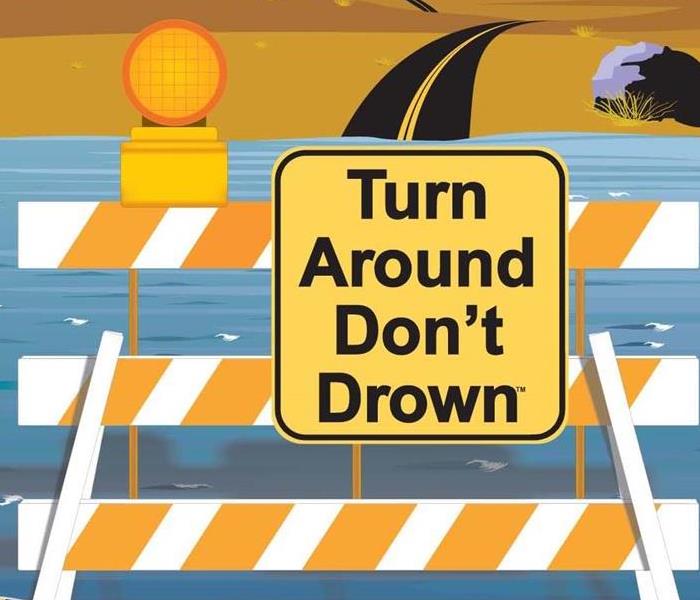 Road construction and flooding.
Road construction and flooding.
Inland Flooding
Inland flooding is the leading weather-related cause of death in the United States. Every year, almost as many people die from flooding as from hurricanes, tornadoes and lightning combined. Most flood-related deaths and injuries could be avoided if people who come upon areas covered with water followed this simple advice:
TURN AROUND, DON’T DROWN.
Inland flooding usually occurs during or after a heavy, slow-moving rain storm. But it also can result from strong coastal storms. Severe inland flooding can occur in areas that are hundreds of miles from the eye of a hurricane.
The reason that so many people drown during flooding is because few of them realize the incredible power of water. A mere six inches of fast-moving flood water can knock over an adult. It takes only two feet of rushing water to carry away a vehicle. This includes pickups and SUVs.
If you come to an area that is covered with water, you will not know the depth of the water or the condition of the ground under the water. This is especially true during the dark, when your vision is more limited.
Play it smart, play it safe. Whether driving or walking, any time you come to a flooded road, TURN AROUND DON'T DROWN!
Flash Floods
Inland flooding that leads to drowning usually occurs during flash-flood conditions.
Flash floods are those that develop within six hours of a rain storm. That may sound like a lot of time, but severe flash floods can occur in a matter of minutes, depending on the intensity and duration of the rain, the topography of an area, and the condition of the soil and ground cover.
Nearly half of all flash-flood fatalities are vehicle-related. The majority of victims are males, but flood deaths affect people of both sexes and all age groups.
Anyone who has witnessed a flash flood can testify to the devastating power of fast-rushing water. Flash floods can roll boulders, uproot trees, destroy buildings and bridges, carry away vehicles and create deep new channels in the earth. Rapidly rising water can reach heights of 30 feet or more. Rain storms that trigger flash floods can also cause catastrophic mud slides.
PREPARE FOR A FLOOD DISASTER IN ADVANCE
We may not be able to control weather conditions, but with only a little bit of planning, we can take all possible precautions to ensure our personal safety and protect our homes from severe damage. Here are some measures you can take to safeguard your home and family:
- Find out how vulnerable your home is to flooding by determining the elevation of your property.
- Evaluate your insurance coverage once a year to make sure your home is fully covered. As new construction grows in certain areas, more flood-plains are sometimes created.
- If your home is in a flood-prone area, contact the National Flood Insurance program to learn what mitigation measures you can take in advance.
- Contact your local emergency management agency to learn how to construct proper protective measures around your home.
- If you live in a flood-prone area, keep these materials on hand: sandbags, plywood, lumber, plastic sheeting, trash bags, shovels, work boots and gloves.
- Purchase a weather radio. These special, battery-operated radios cost as little as $20 and are available at many hardware and appliance stores and other retail outlets.
- Put together a disaster survival kit. Keep the following supplies near at hand and put them in a water-tight container: flashlight with extra batteries, battery-powered radio and weather radio, first aid kit, medicines, eyeglasses, drinking water, non-perishable foods, change of clothes, cash and credit cards, and copies of all important papers.
- Plan two evacuation routes in advance. Don’t wait until threatening weather conditions occur before trying to determine your route to safety. Be aware of streams, drainage channels and low areas in your region that are prone to flooding, so that your evacuation routes are not cut off.
- Do not park your vehicle near streams or rivers, especially during threatening weather conditions.
IF FLOODING OCCURS
Any time there is heavy rain in your area, be sure to follow these simple safety rules:- Listen to NOAA Weather Radio for current and forecasted conditions in your area.
- If flooding begins in your area, go to higher ground immediately.
- When driving, always be aware that the road bed under flood waters may be severely damaged. NEVER drive through flooded roadways. Remember that it takes only two feet of water to carry away a vehicle, including pickups and SUVs.
- When walking, do not attempt to cross flowing streams. Remember that it takes only six inches of rushing water to knock an adult off his feet.
- If your vehicle stalls, get out immediately and go to higher ground.
- Be extra cautious at night, when it is harder to see possible flood dangers.
- These four words could save your life: TURN AROUND, DON’T DROWN.
Hudgens said that after a flood sweeps through your community, keep yourself and your family safe:- Clean and disinfect everything that got wet. Floodwaters pick up sewage and chemicals from roads, farms, factories and storage buildings. Spoiled food, flooded cosmetics and medicines are health hazards. When in doubt, throw them out.
- Soaked carpeting and padding should be pulled up and discarded.
- Look before you step. After a flood, the ground and floors are covered with debris including broken bottles and nails. Floors and stairs that have been covered with mud can be very slippery.
- The use of large fans can speed the drying process and curtail the development of mold.
- Drowning is the number one cause of flood deaths. Most of these drownings occur during flash floods. Six inches of rapidly moving water can knock you off your feet. If you must go through an area where water is standing, use a pole or stick to make sure that the ground is solid under the surface.
- Do not drive through a flooded area. More people drown in their cars than anywhere else. Don't drive around road barriers; the road or bridge may be washed out.
- Stay away from power lines and electrical wires. Electrocution is also a major killer in floods. Electrical current can travel through water. Report downed power lines to your utility company or local emergency manager.
- If the water level got so high that appliances were soaked, turn off your electricity until they can dry out. Some appliances, such as television sets, can shock you even after they have been unplugged. Don't use appliances or motors that have gotten wet unless they have been taken apart, cleaned and dried.
- Be alert for gas leaks. Use a flashlight to inspect for damage. Don't smoke or use candles, lanterns or open flames unless you are sure that the gas has been turned off and the area has been aired out.
- Carbon monoxide exhaust kills. Use a generator or other gasoline-powered machine outdoors. The same goes for camping stoves. Fumes from charcoal are especially deadly; if you must cook with charcoal, use it only outdoors.
- Watch for animals, especially snakes. Small animals that have been flooded out of their homes may seek shelter in yours. Use a pole or stick to poke and turn items over and scare away small animals.
- Are you covered for flood damage? Policies for mobile or manufactured homes may include coverage for flood damage, unlike standard home policies. Owners of traditional site-built homes can purchase federal flood coverage in addition to a standard homeowners policy. However, their community must participate in the federal National Flood Insurance Program. A community cannot be covered unless it has joined the program.
- Flood damage to automobiles is covered under the comprehensive portion of an auto policy.
SERVPRO of Mt. Pleasant, Clare and Houghton Lake can help repair any damage due flooding. Give us a call 24/7at 989-775-5065 where you can speak to one of our representatives.
7 Things You Should Never Forget When Tornadoes Strike
4/23/2018 (Permalink)
1. Figure out a safe place to ride out the storm
Do you live in a mobile home? Get out. Driving in a car? Get home as quickly as you can, and if that's not possible, get to a sturdy building.
2. Get away from windows and get underground
Regardless of where you're hunkering down, it should be as far away from windows as possible. Even if a tornado doesn't hit, wind or hail could shatter windows, and if you're nearby, you could get hurt.
You should make every attempt to get underground during a severe storm, either in a basement or storm shelter. If neither is possible, head to the innermost room or hallway on the lowest floor of your home. The goal is to put as many walls between yourself and the outside world.
3. If a tornado appears while you're on the road ...
You should make every effort to find a safe building for shelter. If you can't find one, NEVER hide under an overpass. Instead, find a ditch, get down and cover your head. Get as far from your vehicle as you can to prevent it from being blown onto you.
4. Put on your shoes – and a helmet
If you're at home and severe weather is bearing down, prepare for the worst. If your house is damaged by a tornado, you could end up walking through debris that's riddled with nails, glass shards and splintered wood. The best way to ensure your shoes aren't scattered is to put on a pair before the storm comes.
If you own a bike helmet, be sure to put it on during a severe storm. It could save you from life-threatening head trauma if your home suffers a direct hit.
5. Keep your pets on a leash or in a carrier, and bring them with you
They're a part of the family, so make sure they go to a safe place with you. Make sure their collar is on for identification purposes, and keep them leashed if they're not in a crate. If your home is damaged by a tornado, it might not be familiar to them anymore, and they might get loose. Be sure to get them to a safe place or put them in a crate while performing clean-up.
6. Don't leave your home and try to drive away from a tornado
If you made it home, stay there. Tornadoes can shift their path, and even if you think you're directly in the line of the storm, being inside shelter is safer than being inside a car. Traffic jams could keep you from getting out of the storm's path, or a small wobble could send the storm in a different direction.
7. Know your severe weather terms
- Severe thunderstorm watch: Conditions are conducive to the development of severe thunderstorms in and around the watch area. These storms produce hail of ¾ inch in diameter and/or wind gusts of at least 58 mph.
- Severe thunderstorm warning: Issued when a severe thunderstorm has been observed by spotters or indicated on radar, and is occurring or imminent in the warning area. These warnings usually last for a period of 30 to 60 minutes.
- Tornado watch: Conditions are favorable for the development of severe thunderstorms and multiple tornadoes in and around the watch area. People in the affected areas are encouraged to be vigilant in preparation for severe weather.
- Tornado warning: Spotters have sighted a tornado or one has been indicated on radar, and is occurring or imminent in the warning area. When a tornado warning has been issued, people in the affected area are strongly encouraged to take cover immediately.
SERVPRO of MT.Pleasant,Clare and Houghton Lake can help repair any damage due to wind . Give us a call 24/7 @ 989-775-5065 where you can speak to one of our representative,
What is Hail Damage and how does it affect my home?
4/23/2018 (Permalink)
What is Hail Damage and how does it affect my home?
Roofing hail damage
When large hail and strong winds exist near residential areas, homes may sustain considerable hail damage to roofing, siding, gutters. Hail is a large frozen raindrop that is produced by intense thunderstorms where snow and rain coexist.
Hail damage can affect your property in many ways. Hail damage to asphalt shingles can cause soft spots or bruising that may or may not be visible to the naked eye. Hail impacts will also tend to loosen the hard granules that make up the top surface of the shingle. In some cases, hail will cause enough damage to break through the shingles felt matting and cause its fibbers to be exposed. Another way to tell if hail has damaged your roof is by checking the roof vents. Hail damage will often cause dents or marks on the metal roof venting systems. If we find evidence of damage to the roof vents first, it usually means you may have sustained shingle damage also.
How can hail damage my siding and guttering systems?
Hail damage to vinyl siding will normally be shown by visual breaks, cracks or holes in the siding product. Normally if these items are not present, your siding has not been damaged. Aluminum siding on the contrary shows damage in other ways. Large hail will produce dents throughout the entire elevation of aluminum siding. Even smaller hail with high velocity crosswinds will produce dents large enough to cause significant damage to the aluminum. Even small dents are considered cosmetic damage by your insurance carrier and in most cases are covered under your property insurance policy. Hail causes similar damages to your aluminum guttering system also. Dents visible from hail are normally cosmetic, but in most cases are still covered by your insurance policy.
SERVPRO of MT.Pleasant,Clare and Houghton Lake can help repair any damage due to Hail. Give us a call 24/7 @ 989-775-5065 where you can speak to one of our representative,
Lightning Damage Facts
4/23/2018 (Permalink)
Each year lightning damage causes billions of dollars in property damage which results often times in a fire event with total devastation. The damage to buildings, equipment, buildings systems, electronics and vehicles can be extensive. Buildings struck by lightning have construction materials which can easily catch fire, smolder or explode. Residential contents such as AV equipment, appliances, electronics, home computers and stereo equipment can be compromised.
In a business setting- all business machines and various equipment types can be electrically shorted and mechanical components become fused resulting in premature failure if not instant total loss. Water pumps blower motors, alarm systems and machinery can be compromised. Building plumbing, HVAC air handlers, heaters and wiring can have extensive damage affecting the operation and control.
Lightning can start a direct fire because the temperature is 90,032°F which is 9 times hotter than the surface of the sun. It is fast too, at 186,000 miles per second- the speed of light, it can reach distances of over 40 land miles in fractions of a second. Lightning strikes somewhere on earth every second translating to over 31,536,000 occurrences per year.
In the U.S. alone, lighting kills more than a hundred persons and injures many more per year. The force of lightning occurs in the sky and is explained as a discharge of atmospheric electricity which is triggered by a buildup of differing charges within a cloud. The result is a sudden release of electricity which causes a distinctive bright flare, followed by a thunderclap and to ground lightning strikes. The theories of how the charges react and are created are numerous. Either way the light show in the sky with all the potential for death and damage is a beautiful phenomenon to watch.
SERVPRO Of Mt.Pleasant, Clare and Houghton Lake are here to help repair any damage due to a lightning strike. Call us @ 989-802-9126 one of our representatives is available 24/7.
FEMA and Mitigation
4/16/2018 (Permalink)
Here is what FEMA says about mitigation (The following was portion copied directly from: https://www.fema.gov/what-mitigation )
“Effective mitigation requires that we all understand local risks, address the hard choices, and invest in long-term community well-being. Without mitigation actions, we jeopardize our safety, financial security and self-reliance.
· Disasters can happen at anytime and anyplace; their human and financial consequences are hard to predict.
· The number of disasters each year is increasing but only 50% of events trigger Federal assistance.
· FEMA's mitigation programs help reduce the impact of events—and our dependence on taxpayers and the Treasury for disaster relief.
FEMA's Federal Insurance and Mitigation Administration (FIMA) manages the National Flood Insurance Program (NFIP) and implements a variety of programs authorized by Congress to reduce losses that may result from natural disasters. Effective mitigation efforts can break the cycle of disaster damage, reconstruction, and repeated damage. FEMA's mitigation and insurance efforts are organized into three primary activities that help states, tribes, territories and localities achieve the highest level of mitigation: Risk Analysis, Risk Reduction, and Risk Insurance. Through these activities and FEMA's day-to-day work across the country, communities are able to make better mitigation decisions before, during, and after disasters.”
Read more by clicking the link provided above.
Some Home Improvements Can See You Behind Bars.
4/16/2018 (Permalink)
Did you know that some DIY projects could put you behind bars? “Just because you can do it yourself doesn’t mean you should. Some jobs call for a licensed professional, especially jobs that involve plumbing, electric, and HVAC installations and repairs. Improperly performed home improvements may cause injury, void warranties, compromise insurance claims, and complicate resales”
Click on the source link below to continue reading and to view the slideshow.
Source: https://www.bobvila.com/slideshow/13-home-improvements-that-are-illegal-to-diy-49321
Check with your local city and county to make sure you are also following proper protocol for them as well. Educate yourself before you begin.Or if you'd like you can call SERVPRO @ 989-775-55065 and we can help you out.
Remolding Old Buildings? You Might Find Mold.
4/11/2018 (Permalink)
Finding mold in your home or commercial property is a precarious situation. Sometimes it may be a localized outbreak that can be easily cleaned away, other times what appears to be a small patch of mold is an indication of a much bigger issue that could be hazardous to the health of those living in the home. SERVPRO of Mt.Pleasant,Clare and Houghton Lake mold remediation is second to none and will evaluate and remediate mold outbreaks.
As many areas in the US see continued growth many old, unoccupied commercial buildings are now opening their doors again. If you encounter mold in your new commercial property SERVPRO of Mt. Pleasant,Clare and Houghton Lake can help. Call our office today and we can send an experienced technician to review your mold issue
Fire Tips to Keep You Safe.
4/11/2018 (Permalink)
No one can predict when an emergency will arise. More than one third of fire home deaths occur as a result of fires where no alarms are present. Most of these smoke alarm failure are usually the result of missing, disconnected, or dead batteries.
Here are some tips to keep in mind that could prevent a fire disaster from occurring in your home:
-National Fire Protection Association recommends smoke alarms be installed in every bedroom, outside all sleeping quarters and on every level of the house
-Test smoke alarms at least once a month using the test button
-Replace batteries in all smoke alarms at least once a year
-Replace all smoke alarms when they are 10 years old.
Emergencies can happen 24/7/365. Keep you and your loved ones safe all year round.
Steps to take if your basement floods.
4/11/2018 (Permalink)
When a basement floods it is a stressful, confusing event which can take a lot of time, money and effort to bring your home back to where it was before the water damage. Whether the damage is caused by a broken water pipe, heavy rains, a failed sump pump or swelling of ground water complicate things further as they all require different approaches to make it "Like it never even happened."
Fortunately here at SERVPRO of Mt.Pleasant, Clare and Houghton Lake we have been able to help families with flooded basements all around Roscommon,Clare,and Mt.Pleasant and are ready to help you. In this blog we will seek to give you general advice for handling flooded basements but do remember our emergency line is open 24/7 and we are here to help you with specific advice for your flooded basement.
Safety for you and your family should be your first concern when you find out your basement has flooded. There are two main safety concerns in every water intrusion situation Electrical and Tripping hazards are the most prevalent source of injury in our industry.
- Never go into a flood damaged basement with standing water which has submerged outlets or other active sources of electricity. Wait for the water to be pumped out by a professional, such as SERVPRO, if you can’t safety do that yourself.
- Most home electronic systems and devices can be damaged from being submerged or exposed to water. Don’t us devices or outlets that have been exposed to water even after the water has been pumped out.
- It is not just the water but also the particulates in the water which will stay behind even after the water has been removed that can damage electrical systems and equipment.
- Not everything breaks immediately it can take time after electrical system is exposed to water before it breaks or becomes unsafe.
- Pay attention to where you are walking, many restoration professionals have hurt themselves walking across different materials (such as carpet to tile) because they didn’t expect the different in friction when these materials are wet.
- If you are removing any materials from your basement remember that wet materials can be VERY heavy.
- Keep out of rooms where ceilings are sagging
When you have accounted for safety you can move on to being proactive about your home and belongings before our restoration technicians get there. Every minute counts which is why we respond 24/7 to emergencies and why anything you do until we get there can help protect your home.
- If possible find the source of water intrusion and stop the flow of water into your property. Check your sump pump to make sure it is working. They sometimes get unplugged or the arm gets stuck. If a pipe is broken shut off your water valve to your home.
- Remove as much water as you can. Using a shop vac, mopping or blotting possible. The less water which is allowed to soak into your furniture, walls and carpet the better off you will be.
- Move furniture off of wet carpet and wipe the legs or bottoms before placing in an unaffected area. Wet furniture, especially wood and metal, can stain carpet very quickly.
- If you cannot remove furniture from an affected area you can place foil or woodblocks between furniture legs and the carpet to prevent staining.
- Remove colored rugs from wet carpeting so their coloring doesn’t bleed onto the carpet.
- Turn on air conditioning for maximum drying in the summer.
Remember that our emergency line 989-775-5065 is always answered by one of the restoration professionals here at SERVPRO so we can give you advice specific to your situation. We are always Here to Help.
Trauma Clean Up.
4/11/2018 (Permalink)
Trauma scene clean up requires handling biohazardous material in a safe and responsible manner. This can include a variety or scenarios that are often emotional and extremely sensitive.
These types of calls require a level of expertise that not all restoration companies are able to provide. Due to federal and state regulations, there is a specific process to follow when damage such as this occurs. Governing bodies such as OSHA, the EPA and CDC have declared their own guidelines and rules for appropriate methods of clean-up.
Bottom line- you need to choose an experienced company who can assist you every step of the way. From understanding the sensitivity of the situation to proper cleanup according regulations, SERVPRO of Mt.Pleasant, Clare and Houghton Lake can assist you in navigating such a stressful situation.
Quality of Your Indoor Air.
4/11/2018 (Permalink)
Over time, harmful contaminants such as dust, dirt, pet dander and bacteria become trapped in your home’s air duct system. Without regular air duct cleaning, your air ducts can become hazardous to your health, diminishing the quality of the air in your home and contributing to illness and allergies. No matter how hard you try to give your home a fresh and clean atmosphere, it requires a professional team with powerful equipment to properly clean your air duct system.
What if You Didn’t Have to Worry About the Quality of Your Indoor Air?
Imagine being absolutely certain that you were providing yourself, your family and the guests in your home with clean and high-quality indoor air each and every day. Using innovative techniques and state-of-the-art technologies, including brushing, air compression and vacuuming, the skilled technicians at SERVPRO of Mt.Pleasant, Clare and Houghton Lake guarantee to leave you with a clean and better functioning air duct system.
SERVPRO's Emergency Ready Profile.
4/11/2018 (Permalink)
As many as 50% of businesses close down following a disaster, according to the latest research. Of the businesses that survive, the overwhelming majority of them had a preparedness plan in place. Pre-planning can serve as an insurance policy aimed at peace of mind. And knowing you are "Ready for whatever happens" speaks trust to your clients and employees that in the event your business is affected by a disaster, they don’t necessarily have to be.
By developing aSERVPRO EmergencyREADYProfilefor your business, you minimize business interruption by having an immediate plan of action. Knowing what to do and what to expect in advance is the key to timely mitigation and can help minimize how water and fire damage can affect your business.
- A no cost assessment of your facility.
This means there is no need to allocate funds, giving you a great value at no cost.
- A concise Profile Document that contains only the critical information needed in the event of an emergency.
It will only take a little time to complete and will not take you away from current projects. But it will save a lot of time if ever needed.
- A guide to help you get back into your building following a disaster.
This can help minimize the amount of time your business is inactive by having an immediate plan of action.
- Establishes your local SERVPRO Franchise Professional as your disaster mitigation and restoration provider.
You have a provider that is recognized as an industry leader and close by.
- Identification of the line of command for authorizing work to begin.
This saves time so we can begin the work of mitigating the damage which can save you time and money.
- Provides facility details such as shut-off valve locations, priority areas and priority contact information.
Having a quick reference of what to do, how to do it and who to call provides solutions in advance of an emergency so that during the emergency you are "Ready for whatever happens."
Contact our office at 989-775-5065 and ask to speak with our ERP Professional
April is Child Abuse Prevention Month.
4/11/2018 (Permalink)

SERVPRO of Mt. Pleasant, Clare and Houghton Lake are proud supporters of the Northern Michigan Children’s Assessment Center. The Northern Michigan Children's Assessment Center assists children that are victims of abuse across four counties in northern Michigan – Crawford, Roscommon, Oscoda and Ogemaw. What is a Children's Assessment Center? Originally, children had to wait in the chaotic environment of a police department to be interviewed when their were concerns of abuse. Now, at the Children's Assessment Center, children wait in a child friendly room surrounded by toys and children's games. This environment allows them to relax and become more open to telling their story. The Children's Assessment Center was created so that children don't have to repeat their story multiple times. Children are interviewed by a specially trained forensic interviewer, in a room designed for them and are no longer interviewed by an officer in uniform. When interviewed at the assessment center, children are more likely to disclose their abuse allowing us to hold offenders accountable and get children the help they need. Inside of the observation room, Law Enforcement and Children's Protective Service workers are able to observe the interview live and participate in the process by directing questions to the interviewer through a headset and an ear-piece. All Interviews are recorded, limiting the number of times children need to tell their story. Children no longer have to go to the chaotic environment of an emergency room for a medical exam. All medicals are performed by a specially trained pediatrician and are scheduled for two hours allowing both the child and the non-offending caregiver adequate time to discuss their concerns. At the Children's Assessment Center, all services are provided under one roof, allowing children to receive all the necessary services to heal from their abuse.
Does Your Home Have A Mold Problem?
8/25/2016 (Permalink)
 In [[City or County Name]], mold can spread through a home in as little as 48 hours.
In [[City or County Name]], mold can spread through a home in as little as 48 hours.
Microscopic mold spores naturally occur almost everywhere, both outdoors and indoors. This makes it impossible to remove all mold from a home or business. Therefore, mold remediation reduces the mold spore count back to its natural or baseline level. Some restoration businesses advertise “mold removal” and even guarantee to remove all mold, which is a fallacy. Consider the following mold facts:
- Mold is present almost everywhere, indoors and outdoors.
- Mold spores are microscopic and float along in the air and may enter your home through windows, doors, or AC/heating systems or even hitch a ride indoors on your clothing or a pet.
- Mold spores thrive on moisture. Mold spores can quickly grow into colonies when exposed to water. These colonies may produce allergens and irritants.
- Before mold remediation can begin, any sources of water or moisture must be addressed. Otherwise, the mold may return.
- Mold often produces a strong, musty odor and can lead you to possible mold problem areas.
- Even higher-than-normal indoor humidity can support mold growth. Keep indoor humidity below 45 percent.
If your home or business has a mold problem, we can inspect and assess your property and use our specialized training, equipment, and expertise to remediate your mold infestation.
If You See Signs of Mold, Call Us Today – 989-775-5065




 24/7 Emergency Service
24/7 Emergency Service








